EVOLUTION for Class 12 BIOLOGY
INTRODUCTION
- Evolutionary Biology is the study of the history of life forms on earth. Evolution basically means the heritable changes that we see in a species over a course of time period. Everything has a origin so in this chapter we would throw some light on the origin of the earth and origin of life. So basically we will study how an existing organism evolves or changes or modifies itself in such a way that it is better suited to live in those changing or existing conditions in comparison to the previous form. We all are hearing nowadays about drug resistant bacteria which basically means that some of the current antibiotics aren’t working. But there was a time when these antibiotics were killing the bacteria so the bacteria somehow changed or modified itself to live in an environment with antibiotics in it. This change which allowed bacteria to survive the antibiotic is what we call as evolution or more specifically the evolution of the drug resistant bacteria.

INTRODUCTION
- Evolutionary Biology is the study of the history of life forms on earth. Evolution basically means the heritable changes that we see in a species over a course of time period. Everything has a origin so in this chapter we would throw some light on the origin of the earth and origin of life. So basically we will study how an existing organism evolves or changes or modifies itself in such a way that it is better suited to live in those changing or existing conditions in comparison to the previous form. We all are hearing nowadays about drug resistant bacteria which basically means that some of the current antibiotics aren’t working. But there was a time when these antibiotics were killing the bacteria so the bacteria somehow changed or modified itself to live in an environment with antibiotics in it. This change which allowed bacteria to survive the antibiotic is what we call as evolution or more specifically the evolution of the drug resistant bacteria.

Chapter Weightage
- The chapter is extremely important from both : exam and understanding biology in a better way; point of view. Question on hardy weinberg principle comes every year whether as a short note or as a long answer question and adaptive radiation alongwith industrial melanism are also the next favourite topics of the examiner while setting up the question paper.
Origin Of Life
- The origin of life is considered a unique event in the history of the universe. The universe is vast. The universe is almost 20 billion years old.Huge clusters of galaxies comprise the universe. Galaxies contain stars and clouds of gas and dust. Considering the size of the universe, earth is indeed a speck. The Big Bang theory attempts to explain to us the origin of the universe. It talks of a singular huge explosion unimaginable in physical terms. The universe expanded and hence, the temperature came down. Hydrogen and Helium formed sometime later. The gases condensed under gravitation and formed the galaxies of the present day universe. In the solar system of the milky way galaxy, earth was supposed to have been formed about 4.5 billion years back. There was no atmosphere on early earth. Water vapour, methane, carbon dioxide and ammonia released from molten mass covered the surface. The UV rays from the sun broke up water into Hydrogen and Oxygen and the lighter H2 escaped. Oxygen combined with ammonia and methane to form water, CO2 and others. The ozone layer was formed. As it cooled, the water vapor fell as rain, to fill all the depressions and form oceans. Life appeared 500 million years after the formation of earth, i.e., almost four billion years ago. There are several theories about how life originated on the earth and we will discuss them below.
- Francesco Redi : Placed cooked meat in 3 jars : uncovered, covered with muslin cloth and one was covered with parchment paper. Maggots developed only in the uncovered jar. Flies visited the jar covered with muslin cloth and laid eggs over it. Eggs which fell into the jar produced maggots.
- Spallanzani : boiled nutrition broth is glass flasks and sealed. No life developed in sealed jars.
- Pasteur : boiled and allowed the nutrition broth in straight neck and swan necked flasks. No germs developed in the flask with a swan neck but microorganisms were seen in the flask with a straight neck.
- Theory of biogenesis is not applicable to origin of life
- The experimental proof for this theory was given by Urey & Miller.
- Experiment :
- The conditions on earth were – high temperature, volcanic storms, reducing atmosphere containing CH4, NH3, etc. Miller created similar conditions in a laboratory scale.
- He created electric discharge in a closed flask containing H2, CH4, NH3 and water vapour at 8000C.
- He observed formation of amino acids. In similar experiments others observed, formation of sugars, nitrogen bases, pigment and fats. Analysis of meteorite content also revealed similar compounds indicating that similar processes are occurring elsewhere in space. With this limited evidence, the first part of the conjectured story, i.e., chemical evolution was more or less accepted.
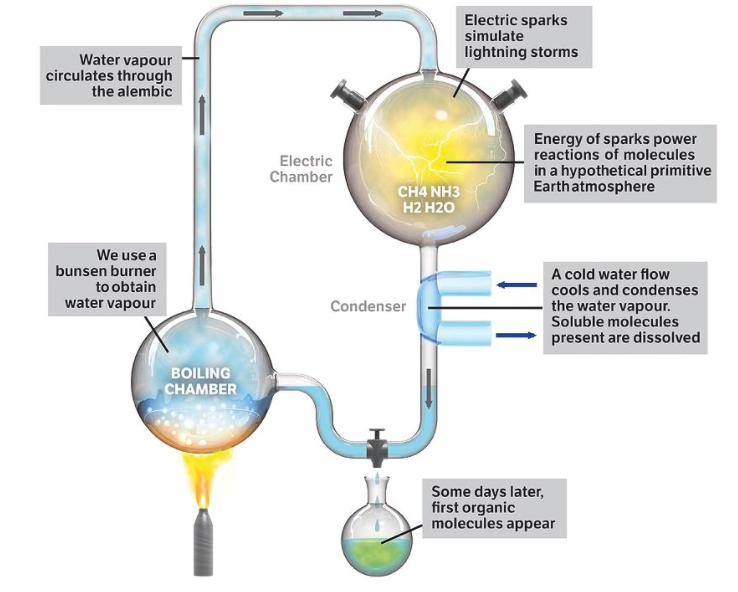
- We still have no idea about how the first self replicating metabolic capsule of life arose.
- The first non-cellular forms of life could have originated 3 billion years back. They would have been giant molecules (RNA, Protein, Polysaccharides, etc.). These aggregated into capsules and these capsules reproduced their molecules perhaps.
- The first cellular form of life did not possibly originate till about 2000 million years ago. These were probably single-cells.
- All life forms were in water environment only. This version of a biogenesis, i.e, The first form of life arose slowly through evolutionary forces from non-living molecules is accepted by majority. However, once formed, how the first cellular forms of life could have evolved into the complex biodiversity of today is still a fascinating story that we will try to explain in future sections.
Theory Of Special Creation : The theory believes that life was created by god. According to the Bible, life was created by God in 7 days. According to hindu mythology, life was created by god. Different religions and faiths have different versions of this theory but all end in the same : life was created by god but there is no scientific proof for this so the theory of special creation is not accepted in the science community.
Theory of Abiogenesis or Theory of Spontaneous Creation : This theory originated in egyption civilization. Different greek philosophers had their own different views. Some thought that life originated from mud warmed by sun, frogs arose from moist soil while others thought that mice originated from human sweat and wheat bran kept in dark for 21 days. Again, this theory also has no scientific basis and thus was discarded by the scientific community.
Biogenesis : Life comes from preexisting life. Theory of spontaneous generation or abiogenesis was disproved by the new concept of "Biogenesis" and different biologists contributed to biogenesis.
Theory of Eternity : This theory given by Preyer in 1880, states that all the life that exists today on the earth have always existed on earth and shall continue to exist in unchanged form till eternity, again this theory also has no scientific base and is not a accepted theory.
Theory of Catastrophism : This theory given by Cuvier says that the world undergoes a cycle of creation and destruction and life emerges after every catastrophism.
Theory of Panspermia/Interplanetary Theory : This theory suggests that life on earth came in the form of spores from other heavenly bodies or other planets through meteorites. Now many meteorites have been found to contain some organic molecules and some bacterial remains. This theory might point towards origin of life as “extraterrestrial” but it simply isn’t possible to carry life from other planets through meteorites because of the high amount of lethal radiation in space.
Biochemical Origin Of Life / Oparin-Haldane Theory : This theory suggests that abiogenesis occurred once (for the first time) known as primary abiogenesis and biogenesis ever since. The main takeaway of this theory is that it took billions of years for the first life to develop during which various organic molecules evolved from the inorganic molecules. These organic molecules aggregated and formed protocells (the first cells) which had the ability to replicate/reproduce and they developed into first living cells. The journey continued from there and these cells kept evolving and evolving into a highly diverse form of life that we see today on the Earth.
Summary of events according to biochemical evolution : Inorganic molecules → organic molecules → Aggregates → Protobionts → Protocells/Eubionts → Earliest cells (developed in sea) - these cells were chemoheterotrophic anaerobic single celled prokaryotes. → Development of Chemoautotrophs → Development of Photoautotrophs → Development of Eukaryotic cells.
Origin Of Life
- Evolution ka simple sa matlab hai ki jo existing life form hai usme ache ke liye badlaav aana. Yhaan par “ache” ka matlab hai survival ke liye. Environment hamesha badalta rehta hai kabhi constant nhi rahega, badalna in the sense ki koi new species aagyi ya koi harmful chemical agent hai ya koi bhi aisi cheez jo uss jagah ke praniyon ke liye khatra bane. Toh aise situation me keval vahi species se individual jinda rahenge jisme koi aisa badlaav aaya ho baki ke comparison jo uss individual me jinda rehne ka ek bdia avsar de yani ki “that variation should offer them a better chance at survival”. Jaise ki aage dekhenge issi phenomenon ko “survival of fittest” bola gya hai. Yeah thodi alag si term hai jiska meaning context ke hisab se badal jata toh isko apun jab jha jaisi jarurat hogi waise discuss kar lenge. Iss section me apne ko evolution term ka matlab samjhna tha jo ki ho chuka or ab yeah padhna hai ki jeevan ki shuruaat kaise hui.
- Purani prithvi ya jab prithvi nyi nyi bani hi thi lagbhag 4.5 billion saal pehle toh atmosphere kafi reducing tha jisme high temperature, ammonia, methane, volcanic eruption vgrah normal toh aaj wali life form kabhi exist hi nahi karti. Prithvi banne ke 500 million saal baad pehli life appear hui thi toh Urey and Miller ne yeah primitive earth ki conditions ka lab me ek replica tyaar kiya jahan par ek flask me unhone H2, CH4, NH3 and water vapour li. Flask me 2 gold electrodes they jo 8000C par spark create karke primitive earth ka high temperature copy kar rhe thy. Yeah sab hota rha. Spark generate karte rhe wo flask me or kuch 7-8 din baad unhone paaya ki flask me amino acids ban gye.In similar experiments others observed, formation of sugars, nitrogen bases, pigment and fats. Toh bas yeah tha simple sa Urey and Miller ka experiment.
Universe kafi purana hai nearly 20 billion years old. Shuru me cosmos ek highly compact dense and high temperature ki state me tha jisme ek bada dhamaka hua. Issi dhamake ko apun angrezi me big bang kahenge. Toh dhamake ke karan cosmos failta gya or thanda hua jiske karan subatomic particles jaise ki atoms vgarah bne. Fir gases bani. Universe failta chla gya or gravitational forces ke karan gases condense hui jisse galaxies bani. Apni galaxy is milky way galaxy. Ab yeah bahut hi basic idea hai big bang and actual me kaise kya hua wo sab toh higher level ki physics ka kaam hai but biology me apun apna dhyan life me focus rakhenge ki theek hai universe bna koi ni physicist deal karenge uske sath but apun deal karenge ki life kaise bani. Pehla cell kaise bna. Kaise humans aaye vgarah vgrah.
Ab dekho life kaise aaie prithvi par toh yeah speculate karte hue kafi theories bnaie gyi jisme me keval ek theory scientists ne accept kari ki bhyii haan yeah science ke laws ke hisab se possible hai and baki theories nahi toh apun un theories ko padhenge.
Sabse pehla or purana vichaar hai ki jeevan bhagwan ne bnaya or yeah theory of special creation alag alag dharma me alag alag tarike se chalti hai but conclusion yeah hai ki jo aaj prithvi pe jeevan hai wo sab bhagwan ne banaya. Ab na toh iska scientific proof ha na explanation or na experiment se yeah prove kia ja sakta hai toh scientists ne iss theory of special creation ko discard kardia or isko nhi apnaya gya.
Fir Greek vasiyon ne apne vichaar rakhe ki life non living matter jaise ki gilli mitti or dhoop se banti hai. Isko kaha gya theory of abiogenesis or theory of spontaneous creation. Lekin scientists ne iss theory ko bhi accept ni kia kyunki koi scientific basis nahi hai iss baat.
Kuch scientists jaise ki Francesco Redi, Spallanzani and Pasteur ne apne apne experiments se yea dikhaya ki life comes from pre-existing life. Yani ki nya jeevan purane jeevo se banta hai. Yeah kehlaie theory of biogenesis. Apun sab jante hai ki reproduction se life banti hai and keval live hi reproduce karke life bna sakte hai toh iss theory ne kuch khaas ni btaya or uper se yeah origin of universe ke liye bhi applicable nhi hai kyunki isne yeah toh bataya hi na ki jeevan ki shuruaat kaise hui.
Kuch ka manna tha ki life prithvi par aisi hi thi time ki shuruaat se or hamesha hamesha ke liye aisi hi bani rahegi - yeah kehlaie theory of eternity jisko Preyer ne 1880 me dia tha but iska bhi koi scientific base nahi hai and isko bhi accept nahi kia gya tha.
Aisi hi milti julti ek or theory hai : theory of catastrophism jo ki Cuvier ne di thi. Inka kehna tha ki puri srishti ke particular time period ke baad pralay/mahanash/vidhvans me jaati hai. Yani ki ek time ke baad earth pe jitni life hai wo ekdam se end ho jayegi jisko catastrophism bola gya and then unke dead remains se new life form emerge hogi or yeah cycle chalta rahega. Isko bhi acceptance nahi mili.
Then aati hai theory of panspermia or interplanetary theory jiska kehna yeah hai ki earth par life dusre greho se meteorite ke dwara aaie hai. Ab kuch meteorite pe hume kuch organic molecules and kuch bacterial type remains jarur mile hai but iska yeah matlab kataiee nhi hai ki prithvi par jitni life form hai wo sari sari ki dusre greho se aaie hai kyunki meteorite ke raaste me prithvi tak aate aate itne harmful radiations hai ki koi life form jinda reh hi nhi payegi jiske karan ek life form ka dusre grah par meteorite ke through jana lagbhag impossible hi hai. Toh yeah bhi accepted theory nhi hai life ke origin ke liye.
Ab aati hai Oparin-Haldane theory ya fir theory of biochemical origin of life which is by far the most accepted theory for the origin of life till now. Yeah theory di toh Oparin and Haldane ne thi but unhone bas btaya ki aisa aisa hua hoga. Unhone koi experimental proof nhi dia tha. Iss theory ka experimental proof dia tha Urey and Miller ne. In short theory yeah kehti hai ki pehle earth par inorganic atoms and molecules thy. Simple molecule like CO2, H2O, N2 vgarah gases thi. Fir inse organic molecules bane jaise ki amino acids, methanes, nucleotides vgrah vgrah. Fir yeah complex molecules aggregate hue ek membrane me. Kafi hit and trial ke baad nature me ek aisa pehla cell bnaya jo ki reproduce kar sakta tha, usme genetic material tha and isme proteins ka synthesis bhi possible hua or in pehle shuruaati cells ko humne protocells kha.. Iss sab kahni ke beech me bahut sare intermediate structure bhi bane jaise ki coacervates and microspheres vgarah jinke baare me yahan discuss karna NCERT ke scope se bahar hai but main cheez hai yeah hai ki protocells se pehle anaerobic single celled prokaryotes develop hue (sea water me) fir chemoautotrophs aaye, unke baad photoautotrophs aaye. Yeah sab abhi tak single celled hi hai mainly. Fir dheere dheere multicellular forms banne lagi. Or yeah protocells se eukaryotes ka safar hai basically evolution hai yani ki har waqt tarakki ki or agrasar rehna or khud me ache ache badlaav lana.
Urey and Miller ke experiment par kabhi kabhi question aajata hai although not necessarily so apun ek baar wo experiment bhi padh lete hain but pehle jo neeche text me pic given hai usko dekho ek baar :
Urey and Miller Experiment
Evolution Of Life Forms – A Theory
- Natural selection and survival of fittest
- Based on observations made during a sea voyage in a sail ship called H.M.S. Beagle round the world, Charles Darwin concluded that existing living forms share similarities to varying degrees not only among themselves but also with life forms that existed millions of years ago.
- Many such life forms do not exist any more. There had been extinctions of different life forms in the years gone by just as new forms of life arose at different periods of history of earth.
- There has been gradual evolution of life forms. Any population has built in variations in characteristics. Those characteristics which enable some to survive better in natural conditions (climate, food, physical factors, etc.) would outbreed others that are less-endowed to survive under such natural conditions.
- Another word used is fitness of the individual or population.
- The fitness, according to Darwin, refers ultimately and only to reproductive fitness. Hence, those who are better fit in an environment, leave more progeny than others. These, therefore, will survive more and hence are selected by nature. He called it natural selection and implied it as a mechanism of evolution.
- Alfred Wallace, a naturalist who worked in Malay Archipelago had also come to similar conclusions around the same time.
- The geological history of earth closely correlates with the biological history of earth.
- Summary of Darwin’s Concept : Darwin based on his studies at Galapagos island concluded that, variations occur in every individual and simultaneously our environment also keeps changing so there will be some variations which will allow that organism to better adapt themselves in that environment. So, nature will select these ’better suited’ individuals against those who either have no beneficial variations or have harmful variations. Of Course it should be kept in mind that according to Charles Darwin the fitness was in terms of robust reproductive health that is species who reproduce quickly and leave more progeny behind have a better chance of surviving as a species than with someone who has low reproduction rate -But, be cautious here that fitness in reality is not always about reproductive fitness, as we will see in later sections.
Origin Of Life
- The origin of life is considered a unique event in the history of the universe. The universe is vast. The universe is almost 20 billion years old.Huge clusters of galaxies comprise the universe. Galaxies contain stars and clouds of gas and dust. Considering the size of the universe, earth is indeed a speck. The Big Bang theory attempts to explain to us the origin of the universe. It talks of a singular huge explosion unimaginable in physical terms. The universe expanded and hence, the temperature came down. Hydrogen and Helium formed sometime later. The gases condensed under gravitation and formed the galaxies of the present day universe. In the solar system of the milky way galaxy, earth was supposed to have been formed about 4.5 billion years back. There was no atmosphere on early earth. Water vapour, methane, carbon dioxide and ammonia released from molten mass covered the surface. The UV rays from the sun broke up water into Hydrogen and Oxygen and the lighter H2 escaped. Oxygen combined with ammonia and methane to form water, CO2 and others. The ozone layer was formed. As it cooled, the water vapor fell as rain, to fill all the depressions and form oceans. Life appeared 500 million years after the formation of earth, i.e., almost four billion years ago. There are several theories about how life originated on the earth and we will discuss them below.
- Francesco Redi : Placed cooked meat in 3 jars : uncovered, covered with muslin cloth and one was covered with parchment paper. Maggots developed only in the uncovered jar. Flies visited the jar covered with muslin cloth and laid eggs over it. Eggs which fell into the jar produced maggots.
- Spallanzani : boiled nutrition broth is glass flasks and sealed. No life developed in sealed jars.
- Pasteur : boiled and allowed the nutrition broth in straight neck and swan necked flasks. No germs developed in the flask with a swan neck but microorganisms were seen in the flask with a straight neck.
- Theory of biogenesis is not applicable to origin of life
- The experimental proof for this theory was given by Urey & Miller.
- Experiment :
- The conditions on earth were – high temperature, volcanic storms, reducing atmosphere containing CH4, NH3, etc. Miller created similar conditions in a laboratory scale.
- He created electric discharge in a closed flask containing H2, CH4, NH3 and water vapour at 8000C.
- He observed formation of amino acids. In similar experiments others observed, formation of sugars, nitrogen bases, pigment and fats. Analysis of meteorite content also revealed similar compounds indicating that similar processes are occurring elsewhere in space. With this limited evidence, the first part of the conjectured story, i.e., chemical evolution was more or less accepted.

- We still have no idea about how the first self replicating metabolic capsule of life arose.
- The first non-cellular forms of life could have originated 3 billion years back. They would have been giant molecules (RNA, Protein, Polysaccharides, etc.). These aggregated into capsules and these capsules reproduced their molecules perhaps.
- The first cellular form of life did not possibly originate till about 2000 million years ago. These were probably single-cells.
- All life forms were in water environment only. This version of a biogenesis, i.e, The first form of life arose slowly through evolutionary forces from non-living molecules is accepted by majority. However, once formed, how the first cellular forms of life could have evolved into the complex biodiversity of today is still a fascinating story that we will try to explain in future sections.
Theory Of Special Creation : The theory believes that life was created by god. According to the Bible, life was created by God in 7 days. According to hindu mythology, life was created by god. Different religions and faiths have different versions of this theory but all end in the same : life was created by god but there is no scientific proof for this so the theory of special creation is not accepted in the science community.
Theory of Abiogenesis or Theory of Spontaneous Creation : This theory originated in egyption civilization. Different greek philosophers had their own different views. Some thought that life originated from mud warmed by sun, frogs arose from moist soil while others thought that mice originated from human sweat and wheat bran kept in dark for 21 days. Again, this theory also has no scientific basis and thus was discarded by the scientific community.
Biogenesis : Life comes from preexisting life. Theory of spontaneous generation or abiogenesis was disproved by the new concept of "Biogenesis" and different biologists contributed to biogenesis.
Theory of Eternity : This theory given by Preyer in 1880, states that all the life that exists today on the earth have always existed on earth and shall continue to exist in unchanged form till eternity, again this theory also has no scientific base and is not a accepted theory.
Theory of Catastrophism : This theory given by Cuvier says that the world undergoes a cycle of creation and destruction and life emerges after every catastrophism.
Theory of Panspermia/Interplanetary Theory : This theory suggests that life on earth came in the form of spores from other heavenly bodies or other planets through meteorites. Now many meteorites have been found to contain some organic molecules and some bacterial remains. This theory might point towards origin of life as “extraterrestrial” but it simply isn’t possible to carry life from other planets through meteorites because of the high amount of lethal radiation in space.
Biochemical Origin Of Life / Oparin-Haldane Theory : This theory suggests that abiogenesis occurred once (for the first time) known as primary abiogenesis and biogenesis ever since. The main takeaway of this theory is that it took billions of years for the first life to develop during which various organic molecules evolved from the inorganic molecules. These organic molecules aggregated and formed protocells (the first cells) which had the ability to replicate/reproduce and they developed into first living cells. The journey continued from there and these cells kept evolving and evolving into a highly diverse form of life that we see today on the Earth.
Summary of events according to biochemical evolution : Inorganic molecules → organic molecules → Aggregates → Protobionts → Protocells/Eubionts → Earliest cells (developed in sea) - these cells were chemoheterotrophic anaerobic single celled prokaryotes. → Development of Chemoautotrophs → Development of Photoautotrophs → Development of Eukaryotic cells.
Evidences For Evolution
- We have talked about evolution that existing life forms on the Earth undergo slow and gradual change that we call as evolution and it is this very evolutionary process that leads to formation of new species and enhances the richness of diversity of a biome. Simply put life begin as a single celled but evolved to highly advanced multicellular organisms at the apex of the food chain that we call as Homo sapiens. So, there has to be some evidence that evolutions indeed did happen or is still happening. These evidences prove that when evolution happens or when a new species arises from an existing species then they had to have a common ancestor and when multiple species have a common ancestor, they also have some similar characteristics, albeit to varying degrees. One of the basic and most important evidence is : fossil record.
- For example whales, bats, Cheetah and humans (all mammals) share similarities in the pattern of bones of forelimbs. Though these forelimbs perform different functions in these animals, they have similar anatomical structure – all of them have humerus, radius, ulna, carpals, metacarpals and phalanges in their forelimbs. Hence, in these animals, the same structure developed along different directions due to adaptations to different needs. This is divergent evolution and these structures are homologous.
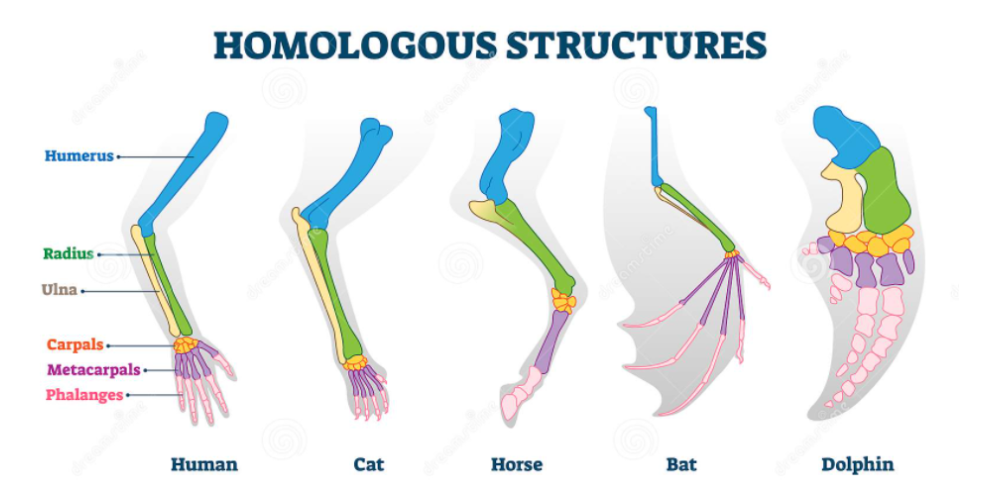
- Other examples are vertebrate hearts or brains. In plants also, the thorn and tendrils of Bougainvillea and Cucurbita represent homology.
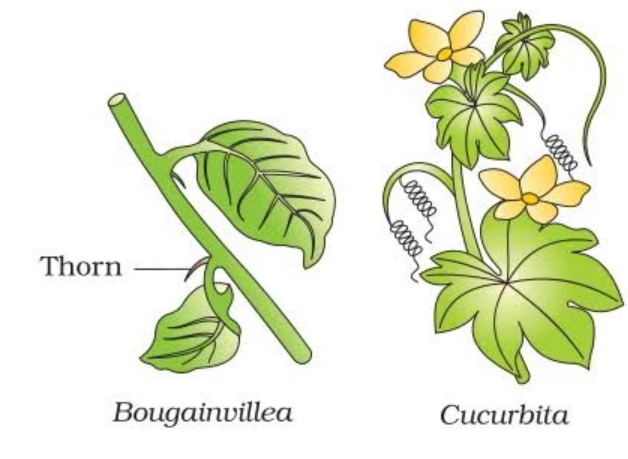
- Phenomenon : In a collection of moths made in 1850s, i.e., before industrialisation set in, it was observed that there were more white-winged moths on trees than dark-winged or melanised moths. However, in the collection carried out from the same area, but after industrialisation, i.e., in 1920, there were more dark-winged moths in the same area, i.e., the proportion was reversed.
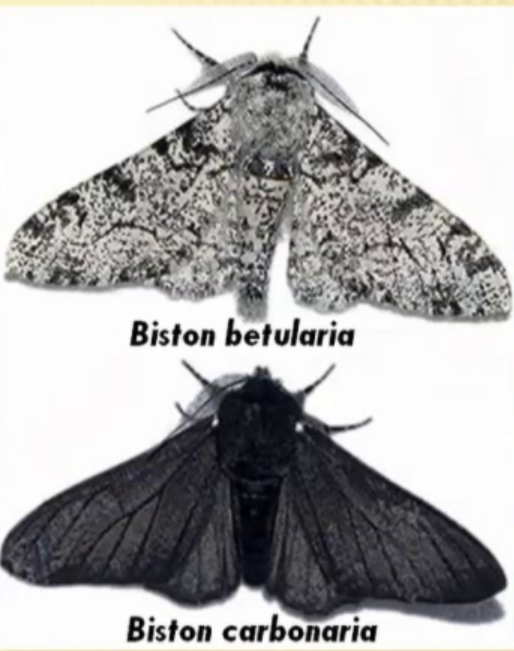
- Explanation : The explanation put forth for this observation was that ‘predators will spot a moth against a contrasting background’. During the post industrialisation period, the tree trunks became dark due to industrial smoke and soots. Under this condition the white-winged moth did not survive due to predators, dark-winged or melanised moths survived. Before industrialisation set in, thick growth of almost white-coloured lichen covered the trees - in that background the white winged moth survived but the dark-coloured moth was picked out by predators. Do you know that lichens can be used as industrial pollution indicators? They will not grow in areas that are polluted. Hence, moths that were able to camouflage themselves, i.e., hide in the background, survived. This understanding is supported by the fact that in areas where industrialisation did not occur e.g., in rural areas, the count of melanic moths was low. This showed that in a mixed population, those that can better-adapt, survive and increase in population size. Remember that no variant is completely wiped out.
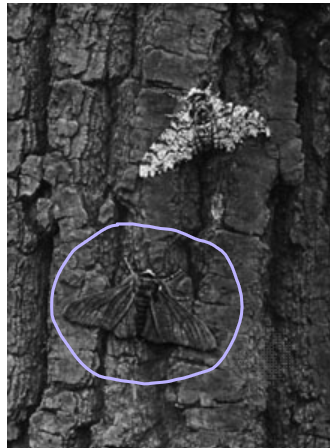
Fossils - a paleontological evidence: Fossils are remains of hard parts of life-forms found in rocks. Rocks form sediments and a cross-section of earth's crust indicates the arrangement of sediments one over the other during the long history of earth. Different-aged rock sediments contain fossils of different life-forms who probably died during the formation of the particular sediment. Some of them appear similar to modern organisms. They represent extinct organisms (e.g., Dinosaurs). A study of fossils in different sedimentary layers indicates the geological period in which they existed. The study showed that life-forms varied over time and certain life forms are restricted to certain geological timespans. Hence, new forms of life have arisen at different times in the history of earth. All this is called paleontological evidence.
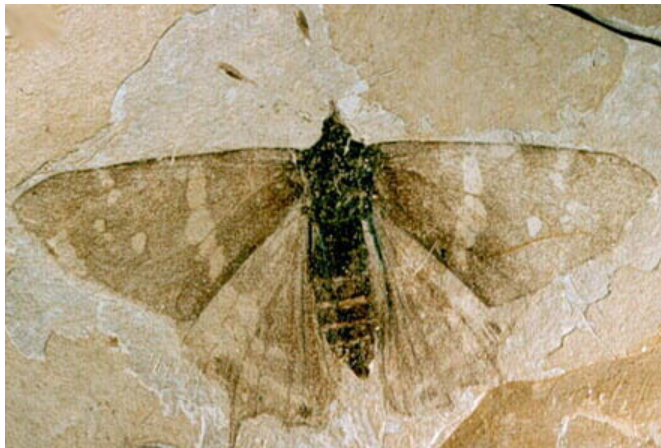
Fig : Fossil of a Butterfly
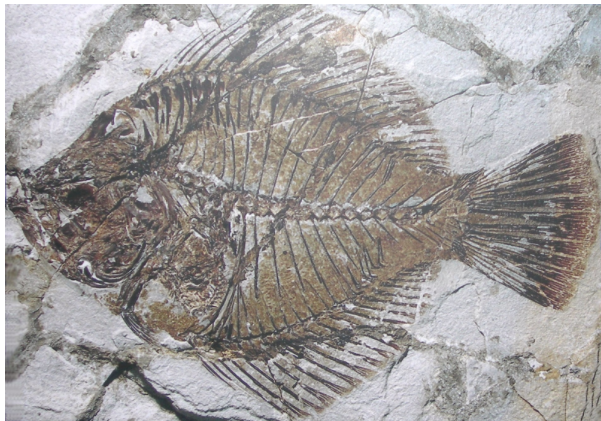
Homologous Organs : The organs in different organisms which have the same origin but perform different functions in different organisms (due to adaptations of different organisms to different needs) are known as homologous organs.
- Now what do they indicate??
Answer : Homology indicates common ancestry. The reason is that different structures in different organisms can have similar origins only if all of them evolved at one point in a common ancestor. And then with time, the progeny of that common ancestor migrated to different environments, their needs changed and hence they adapted themselves to their new habitat and this is what we call as divergent evolution.
Analogous Organs : Exactly opposite of homologous organs that is they have similar function but they do not have similar origins. Wings of butterfly and of birds look alike. They are not anatomically similar structures though they perform similar functions.

Hence, analogous structures are a result of convergent evolution - different structures evolving for the same function and hence having similarity. Other examples of analogy are the eye of the octopus and of mammals or the flippers of Penguins and Dolphins. We can say that similar habitat that has resulted in selection of similar adaptive features in different groups of organisms but toward the same function: Sweet potato (root modification) and potato (stem modification) is another example for analogy.
Industrial Melanism
Antibiotic resistance microbes : There was a time 40-50 years back when limited antibiotics were highly effective against a plethora of bacteria. But nowadays those antibiotics don’t work on more than 95% bacterias and the answer is simple : bacteria developed antibiotic resistance which simply means that bacteria now can live even in the presence of antibiotics. Bacteria developed several mechanisms (some of which we don’t even know) which nullifies the effect of antibiotics. Then we developed more powerful antibiotics, which worked on bacteria for a few decades but soon the bacteria again evolved into more resistant bacteria. The most common cause is overdoing the antibiotics. People nowadays and for the past 1-2 decades have been popping them like candies even in diseases where antibiotics don’t work like in case of prion or viral infections or allergies. This overuse forced bacteria to either die or evolve into something powerful that can survive even in the presence of this poison (antibiotic). As a result now we have antibiotic resistant TB bacteria, MRSA bacteria which are a major concern for the health departments. MRSA is especially common in hospitals.

Evolution Of Life Forms – A Theory
- Iss section me apun deal karenge ki evolution hua kaise. Although yeah pura part chapter ke different sections me thoda thoda banta hua hai but yahan par isko one go me karenge. Toh story shuru karte hai :
- Charles Darwin H.M.S Beagle naam ke jahaj par thy or wo Galapagos naam ke island pe pahuche. Vahan par unhe finches (ek strike ka beej khane wal chotu sa pakshi) mile jinko baad me Darwin’s finches bola gya. Khair unhone paya ki yeah finches although different species hai but ek hi ancestor se evolve hui hai kyunki island par food change hota gya over a course of time period. Inhi finch’s ki 12 species hai jo 2 subfamilies me divided hai. Sabki beak alag alag hai depending on the food source they eat. Yani ki yeah jo finches thy unhone khud ko changing food source ke sath khud ko badal liya ya kahe ki evolve kar lia. Ab dekho island par food badal rha hai mano ki seeds nhi hai ab and inko cactus plant jo ki jyadatar paya jata hai vhan pe, wo hi khakr kaam chalana padega. Toh finches ke pass 2 option hai : ya toh seeds khatam ho rahe hai toh bhukhe raho or bhukhmari se maro ya khud ko itna change karo ki kaanto se bachkar cactus se tum food le sako. Yhaan twist aata hai ki seed eating walo ki beak choti hai or cactus kahne walo ki beak lambi patli or nukeeli. Toh short seed eating beak wali population me kuch aise finches rahe honge jinme sexual reproduction ke karan variation aaya or uski vajah se unki beak lambi, patli nukeeli ho gyi. Ab yeah long beak generally seed kahne ke kaam ni aati toh jab food source keval seed hai toh yeah disadvantageous hai but jab island pe seeds khatam ho rahe toh yhi beak cactus se food lene ke kaam aayegi or ab keval vhi finches jinda bachenge jinki beak lambi nukeeli hai or wo cactus kha kar jinda reh sakte hain. Toh yahan nature se select kiya ki ab is waqt lambi beak walo ko rakho or choti beak walo ko hatao. Issi ko hum natural selection bolte hain. Toh unhone yahan se apni theory di ki evolution ke liye natural selection responsible hai. Natural selection jaise ki naam hi bta rha hai, nature select karta hai ki konsa individual zinda rehne ke sabse fit hai. This is what he called as survival of the fittest. Ki bhyii jo kamzor hai wo lupt ho jayenge. Kamjor or takatwar yhaan keval reproduction ki terms me hai as of now ki slow reproducing species will leave less species jabki jaldi jaldi reproduce karne wale jyada progeny piche chorenge. Toh agar predator aa gaya toh shikaar karega obviously usse hoga yeah ki slow reproducing ki population jyada jaldi decrease hogi as compared to a species with high reproduction rate.
I hope uper wali kahani se natural selection and survival of the fittest jaise terms clear ho gyi hongi and idea lga hoga ki evolution kaise hota hai.
Adaptive Radiation
- Adaptive simply refers to the term - adaptation. The changes that occur in organisms with regards to the changing habitat or changing environment in other senses or changes in food habits- all such changes lead to evolution. When different organisms come to live in the same habitat then they will have the same features in common which are better suited to adapt to that environment. The evolution led by these changes is known as convergent evolution which again refers to the fact that different organisms converged to a single habitat and then evolved from there. Adaptive radiation refers to the diversification of a group of organisms into forms filling different ecological roles and it leads to convergent evolution generally seen by presence of analogous organs.
- During his journey Darwin went to the Galapagos Islands. There he observed an amazing diversity of creatures. Of particular interest, small black birds later called Darwin’s Finches amazed him. He realised that there were many varieties of finches on the same island. All the varieties, he conjectured, evolved on the island itself. From the original seed-eating features, many other forms with altered beaks arose, enabling them to become insectivorous and vegetarian finches. This process of evolution of different species in a given geographical area starting from a point and literally radiating to other areas of geography (habitats) is called adaptive radiation. Darwin’s finches represent one of the best examples of this phenomenon.
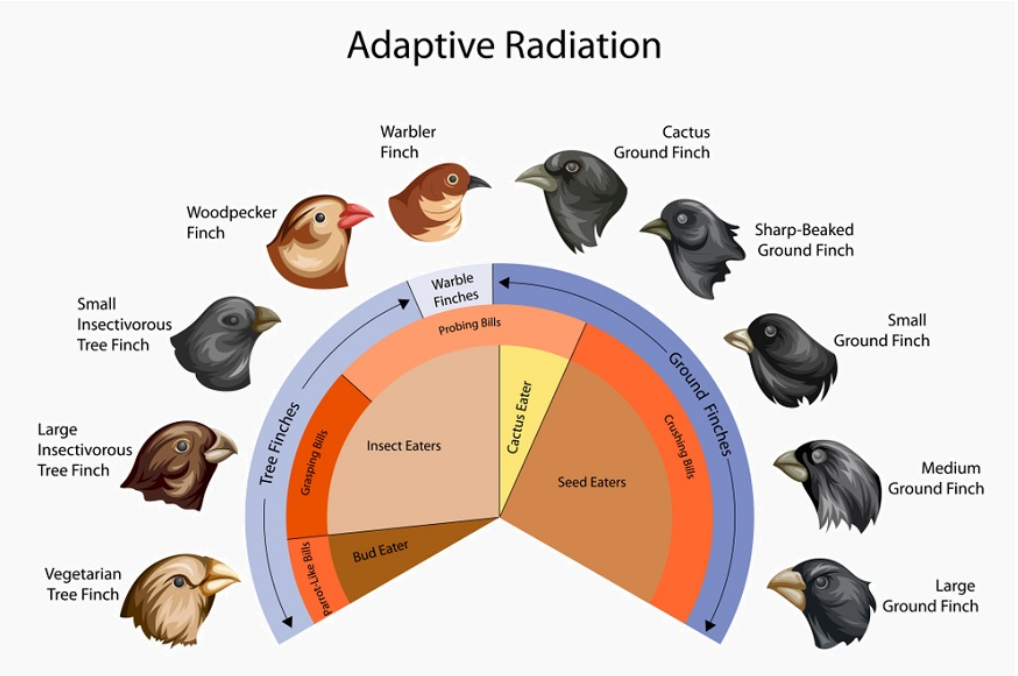
- number of marsupials, each different from the other evolved from an ancestral stock, but all within the Australian island continent. When more than one adaptive radiation appears to have occurred in an isolated geographical area (representing different habitats), one can call this convergent evolution.
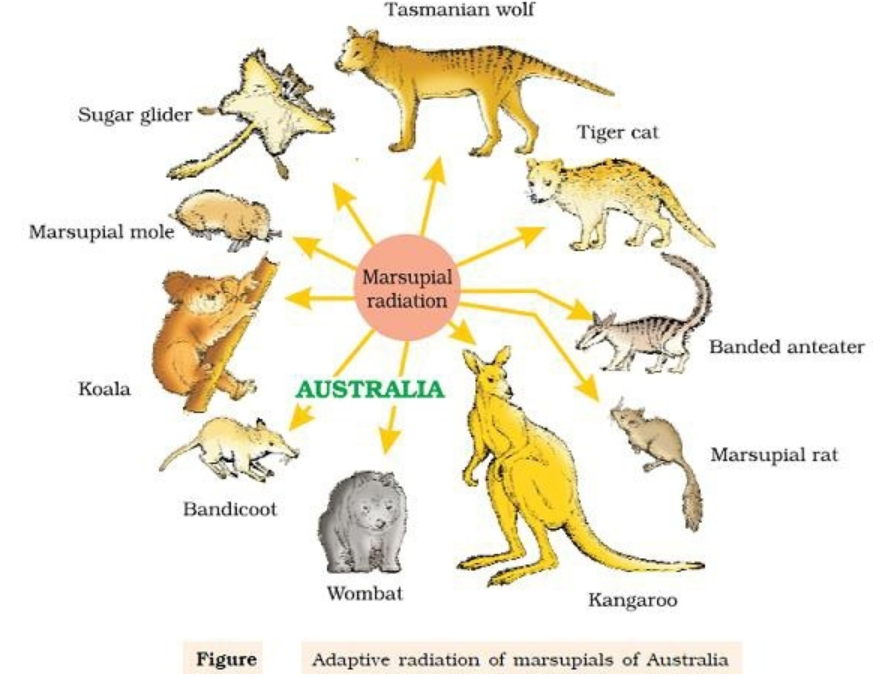
- Placental mammals in Australia also exhibit adaptive radiation in evolving into varieties of such placental mammals each of which appears to be ‘similar’ to a corresponding marsupial (e.g., Placental wolf and Tasmanian wolf-marsupial).
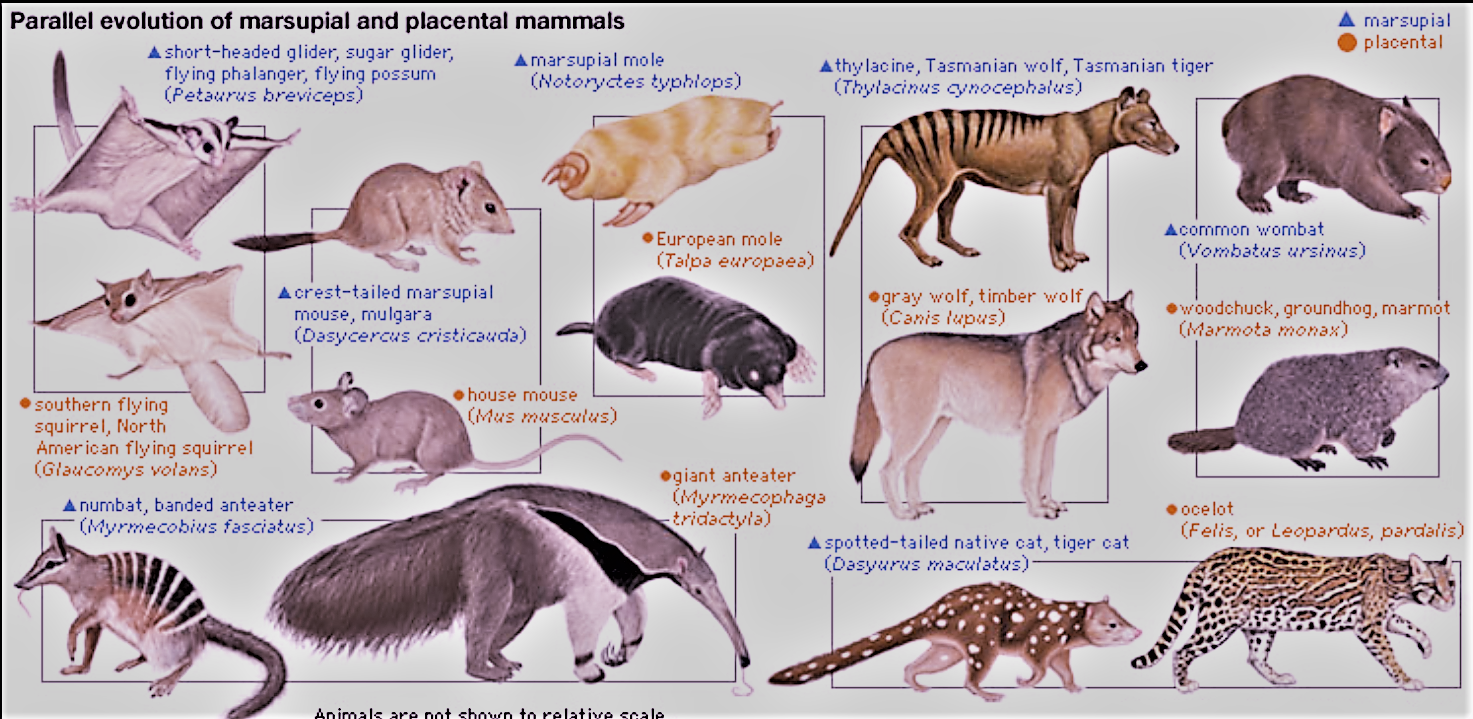
Darwin and Darwin’s Finches :
Australian Marsupial is another example for adaptive evolution :
Evolution Of Life Forms – A Theory
- Natural selection and survival of fittest
- Based on observations made during a sea voyage in a sail ship called H.M.S. Beagle round the world, Charles Darwin concluded that existing living forms share similarities to varying degrees not only among themselves but also with life forms that existed millions of years ago.
- Many such life forms do not exist any more. There had been extinctions of different life forms in the years gone by just as new forms of life arose at different periods of history of earth.
- There has been gradual evolution of life forms. Any population has built in variations in characteristics. Those characteristics which enable some to survive better in natural conditions (climate, food, physical factors, etc.) would outbreed others that are less-endowed to survive under such natural conditions.
- Another word used is fitness of the individual or population.
- The fitness, according to Darwin, refers ultimately and only to reproductive fitness. Hence, those who are better fit in an environment, leave more progeny than others. These, therefore, will survive more and hence are selected by nature. He called it natural selection and implied it as a mechanism of evolution.
- Alfred Wallace, a naturalist who worked in Malay Archipelago had also come to similar conclusions around the same time.
- The geological history of earth closely correlates with the biological history of earth.
- Summary of Darwin’s Concept : Darwin based on his studies at Galapagos island concluded that, variations occur in every individual and simultaneously our environment also keeps changing so there will be some variations which will allow that organism to better adapt themselves in that environment. So, nature will select these ’better suited’ individuals against those who either have no beneficial variations or have harmful variations. Of Course it should be kept in mind that according to Charles Darwin the fitness was in terms of robust reproductive health that is species who reproduce quickly and leave more progeny behind have a better chance of surviving as a species than with someone who has low reproduction rate -But, be cautious here that fitness in reality is not always about reproductive fitness, as we will see in later sections.
Biological Evolution
- The term biological evolution basically means evolution of life forms. Ab chahe koi bhi life form ho bacteria ho koi animal ho ya koi or life form ho. Biological evolution is basically driven by natural selection - a concept given by Darwin.
- The rate of appearance of new forms is linked to the life cycle or the life span. Microbes that divide fast have the ability to multiply and become millions of individuals within hours.
- Nature selects for fitness and this fitness is based on characteristics which are inherited.
- Adaptive ability is inherited. It has a genetic basis. Fitness is the end result of the ability to adapt and get selected by nature.
- Branching descent and natural selection are the two key concepts of Darwinian Theory of Evolution.
- Branching Descent : the process of development of a new species from a single common descendant. This happens when more and more favourable variations keep accumulating in one descent who eventually evolves into a new species and thus gets separated from its parent species.
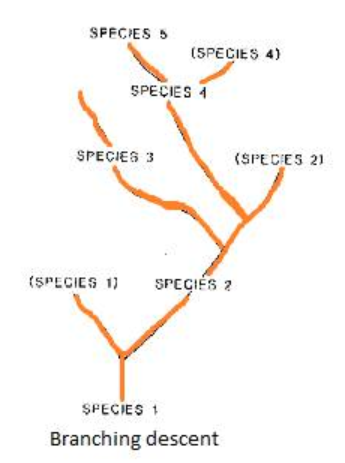
- Lamarckism : Before Darwin, another naturalist names Lamarck had said that evolution of life forms had occurred but driven by use and disuse of organs. He gave the examples of Giraffes who in an attempt to forage leaves on tall trees had to adapt by elongation of their necks. As they passed on this acquired character of elongated neck to succeeding generations, Giraffes, slowly, over the years, came to acquire long necks. Nobody believes this conjecture any more.
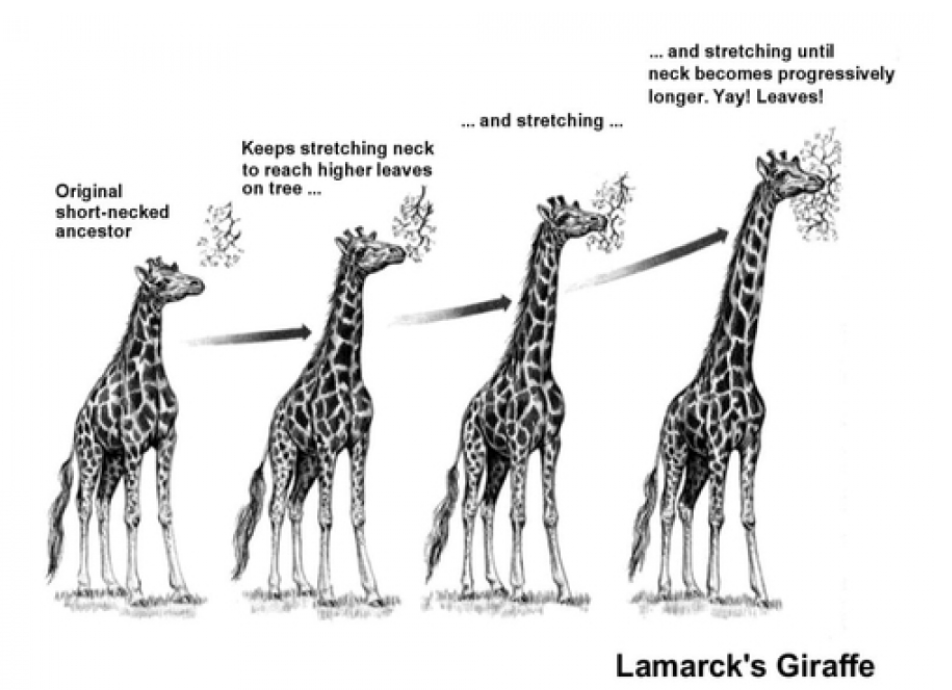
- Darwinism : Darwin’s concept of evolution by natural selection is known as Darwinism and is an accepted mechanism of evolution although it's an old concept and nowadays new concept known as Neodarwinisn is in play.
- It is possible that the work of Thomas Malthus on populations influenced Darwin.
- Natural selection is based on certain observations which are factual. For example, natural resources are limited, populations are stable in size except for seasonal fluctuation, members of a population vary in characteristics (in fact no two individuals are alike) even though they look superficially similar, most variations are inherited etc.
- The fact that theoretically population size will grow exponentially if everybody reproduced maximally (this fact can be seen in a growing bacterial population) and the fact that population sizes in reality are limited, means that there has been competition for resources.
- Only some survived and grew at the cost of others that could not flourish.
- The novelty and brilliant insight of Darwin was this: he asserted that variations, which are heritable and which make resource utilisation better for few (adapted to habitat better) will enable only those to reproduce and leave more progeny. Hence for a period of time, over many generations, survivors will leave more progeny and there would be a change in population characteristic and hence new forms appear to arise.
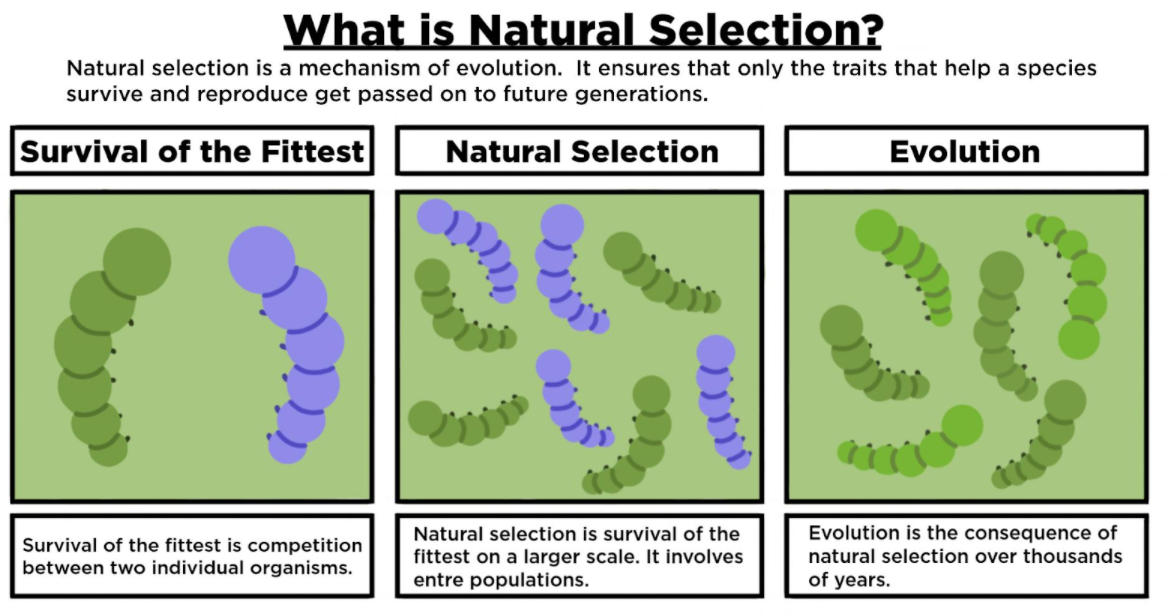
Evidences For Evolution
- Ab tak hume padha origin of life, usse related theories and then evolution kaise hota hai usse related theories. Lekin scientist log bina saboot ke kuch ni maante toh ab apun padhenge ki bhyii saboot kya hai ki evolution sadiyon se hota aa raha hai ya na. 4-5 gini chuni cheezein hai jo evolution ka saboot kehlati hai jaise ki : homology, analogy, fossils and kuch relatively new examples like industrial melanism and development of antibiotic resistant bacteria. Toh ek ek karke dekhte hai inko bhi…
Fossils : jo life form kisi purane samay me jinda thi, unki body ke remains ya unke prints jo bhi aaj bache hue hain wo fossils kehlate hai. Jaise maanlo ek time par dinosaur thy. right?
Nahi yrr kyu manoge ki dinosaur actual me thy ya na? Sabut hai tumhare pass? Movies hamesha sach nhi hoti. But yes dinosaurs are real because we have fossil record. Toh jo dinosaurs ek time par prithvi pe vicharte thy, unki death hui, death hui toh bones we know ki haddiyan itni aasani se nhi galti jitni aasani se baki soft tissue decompose ho jata hai. Toh dead body hai dinosaur ki ek place pe. Time badalta gaya. Mausam badalta gaya. Aandhi tufan aaya or mitti jamne lagi. Aise sadiyon tak mitti jamti rehi uss dead animal par jiska nateeja yeah hua ki aaj hajaro saal baad hum humans ko pahado or gufaon mein dinosaurs ke remains yani ki bachi hui bones ya skin ke prints ya scales ke prints vgarah mile jo fossils kehlate hain jinko paleontologists search and study karte hain. Toh fossils bta rahe hai ki ek samay pe prithvi par aise jeevan hai or aaj hume pata hai aisa jeevan hai toh yeah prove krta hai pehle jo jeev thy or aaj wali present form me vikshit hue yani ki evolve hue.
Next is analogous organs. Analogous organs hai different jeevo me jinka function same hai lekin origin (yani ki embryo me konsi layer se kaise bane aur kab bane) wo different hai. For example wings of a butterfly, bat and a common bird all have same function. Sabhi ka kaam hai udna. Lekin butterfly insect hai beta, arthropoda phylum se belong karti hai and bird class aves se or bat class mammalia se. Toh ofcourse inke development embryo me alag alag hui hai lekin function same kyu hai? Kyunki yeah sabhi ek common feature yani ki flight ke liye adapted hai. Jab aisa ho ki unrelated organisms alag alag jgaha se aakr ek habit me common structures develop karle wo convergent evolution hai. Ek or example se samjho isko : fins of fishes and flippers or whale : dono ka kaam hai swim me help karna lekin fish class pisces se belong karti hai or whale class mammalia toh inke fin alag alag hai. Fish ke fins me bone nhi hoti lekin whale although mammal hai still flippers hai uske paas jisme normal wo bones hoti hai jo normal mammal ke front limb me milti hai. Toh machli or whale do alag alag animals ek jagah ek common habitat paani me converge hue hai toh dono me same structures bane and this is what we call as convergent evolution.
Next, we have homologous organs. Yeah aise organs hai jinka internal structure same hai but function different ho sakta hai jaise ki forelimbs of human, cat, bat and dolphin. Sabke forelimb basic bones se bani hai which are : humerus, radius, ulna, carpels, metacarpals and phalanges. Homology shows divergent evolution. Wo aise ki jab internal structure jo ki DNA me encoded hai wo same hai toh kahi na kahi kisi purane samay me inka koi ek common ancestors raha hoga jisme yeah characters thy and uss common ancestor se alag hoke yeah alag alag environment ya habitat me rehne lag gya jinke kuch modification toh aaie jo hume bahar se dikh rhi hai jaise bat apna forelimb udne ke liye use kar hai jabki humans various functions ke liye. Toh jo yeah ek common ancestor se divergre hoke yani ki alag hoke evolution hua hai this is what we call as divergent evolution.
Industrial Melanism
Yeah bda classic example hai Biston betularia (white winged moth) and Biston carbonaria (Dark/coloured winged moth) ki population ke size ka. 1850 me jab industries vgarah itni nhi thi toh pollution kam tha and trees me bdia white coloured lichen grow karta tha. Ab iss white lichen me white winged moth predators ko nahi dikhta tha lekin black winged moth alag se dikhta tha toh predators B. carbonaria ka shikar karte rehte thy jiske karan dark winged moth ki population kam thi. Lekin 1920 me industrialisation shuru hua and bahut sari industries se bhar bhar ke pollution, smoke and soot particles ki vajah se lichen grow ni kar payi and trees ki stem dark coloured ki hone lagi toh ab dark winged moth predators ko nhi dikh rha tha lekin white winged moth ache se dikh rha tha toh white ka shikar hota gya and iski population kam hogyi. Toh yeah bada simple and yet excellent example hai natural selection ka. yaad karo natural selection me Darwin ki baat karte hue discuss kiya tha “ survival of fittest” jaha reproductive health ki baat kari thi ki jiski jitni reproductive capacity jyada hogi uske survive karne ke chances jyada hai lekin yahan dekho yahan bhi natural selection hua, yahan bhi survival of fittest hai lekin yhan fit reproduction ki terms me nhi balki predators se bachne ki terms me hai. Toh khud ko camouflage karna predation se bachna is also a “fit” characteristic which nature selected for survival.
Ek or new sa example hai “ rise of antibiotic resistant microbes” jo ki generally books me nhi dia jata and thoda new new concept hai toh neeche given hai wo, do read that also.
Mechanism Of Evolution
- Till now we studied that evolution occurs by natural selection and variations, specifically the favourable variations in an individual are responsible for its fitness and natural selection but What is the origin of this variation and how does speciation occur?
- Even though Mendel had talked of inheritable 'factors' influencing phenotype,Darwin either ignored these observations or kept silence. Had Darwin paid attention to Mendel’s work he would have been able to explain what variations are and how they work and he’d probably have provided physical evidence or not.
- In the first decade of twentieth century, Hugo de Vries based on his work on evening primrose brought forth the idea of mutations – large differences arising suddenly in a population. He believed that it is mutation which causes evolution and not the minor variations (heritable) that Darwin talked about.
- Mutations are random and directionless while Darwinian variations are small and directional.
- Evolution for Darwin was gradual while deVries believed mutation caused speciation and hence called it saltation (single step large mutation).
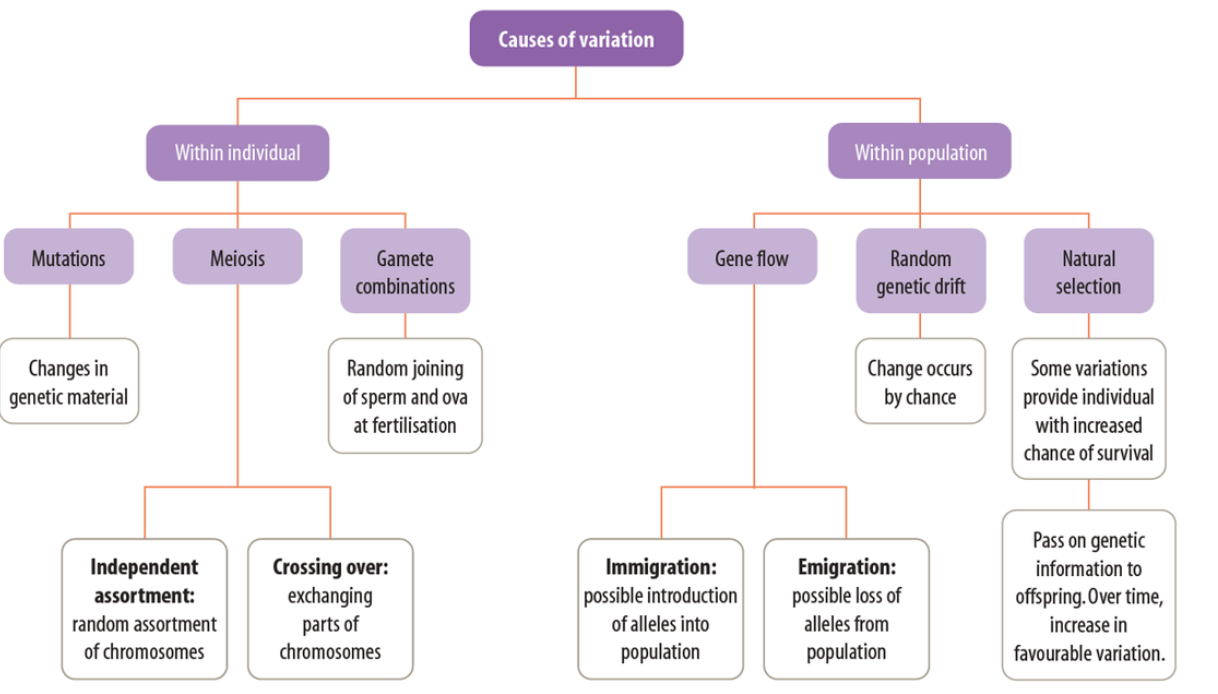
Evidences For Evolution
- We have talked about evolution that existing life forms on the Earth undergo slow and gradual change that we call as evolution and it is this very evolutionary process that leads to formation of new species and enhances the richness of diversity of a biome. Simply put life begin as a single celled but evolved to highly advanced multicellular organisms at the apex of the food chain that we call as Homo sapiens. So, there has to be some evidence that evolutions indeed did happen or is still happening. These evidences prove that when evolution happens or when a new species arises from an existing species then they had to have a common ancestor and when multiple species have a common ancestor, they also have some similar characteristics, albeit to varying degrees. One of the basic and most important evidence is : fossil record.
- For example whales, bats, Cheetah and humans (all mammals) share similarities in the pattern of bones of forelimbs. Though these forelimbs perform different functions in these animals, they have similar anatomical structure – all of them have humerus, radius, ulna, carpals, metacarpals and phalanges in their forelimbs. Hence, in these animals, the same structure developed along different directions due to adaptations to different needs. This is divergent evolution and these structures are homologous.

- Other examples are vertebrate hearts or brains. In plants also, the thorn and tendrils of Bougainvillea and Cucurbita represent homology.

- Phenomenon : In a collection of moths made in 1850s, i.e., before industrialisation set in, it was observed that there were more white-winged moths on trees than dark-winged or melanised moths. However, in the collection carried out from the same area, but after industrialisation, i.e., in 1920, there were more dark-winged moths in the same area, i.e., the proportion was reversed.

- Explanation : The explanation put forth for this observation was that ‘predators will spot a moth against a contrasting background’. During the post industrialisation period, the tree trunks became dark due to industrial smoke and soots. Under this condition the white-winged moth did not survive due to predators, dark-winged or melanised moths survived. Before industrialisation set in, thick growth of almost white-coloured lichen covered the trees - in that background the white winged moth survived but the dark-coloured moth was picked out by predators. Do you know that lichens can be used as industrial pollution indicators? They will not grow in areas that are polluted. Hence, moths that were able to camouflage themselves, i.e., hide in the background, survived. This understanding is supported by the fact that in areas where industrialisation did not occur e.g., in rural areas, the count of melanic moths was low. This showed that in a mixed population, those that can better-adapt, survive and increase in population size. Remember that no variant is completely wiped out.

Fossils - a paleontological evidence: Fossils are remains of hard parts of life-forms found in rocks. Rocks form sediments and a cross-section of earth's crust indicates the arrangement of sediments one over the other during the long history of earth. Different-aged rock sediments contain fossils of different life-forms who probably died during the formation of the particular sediment. Some of them appear similar to modern organisms. They represent extinct organisms (e.g., Dinosaurs). A study of fossils in different sedimentary layers indicates the geological period in which they existed. The study showed that life-forms varied over time and certain life forms are restricted to certain geological timespans. Hence, new forms of life have arisen at different times in the history of earth. All this is called paleontological evidence.

Fig : Fossil of a Butterfly

Homologous Organs : The organs in different organisms which have the same origin but perform different functions in different organisms (due to adaptations of different organisms to different needs) are known as homologous organs.
- Now what do they indicate??
Answer : Homology indicates common ancestry. The reason is that different structures in different organisms can have similar origins only if all of them evolved at one point in a common ancestor. And then with time, the progeny of that common ancestor migrated to different environments, their needs changed and hence they adapted themselves to their new habitat and this is what we call as divergent evolution.
Analogous Organs : Exactly opposite of homologous organs that is they have similar function but they do not have similar origins. Wings of butterfly and of birds look alike. They are not anatomically similar structures though they perform similar functions.

Hence, analogous structures are a result of convergent evolution - different structures evolving for the same function and hence having similarity. Other examples of analogy are the eye of the octopus and of mammals or the flippers of Penguins and Dolphins. We can say that similar habitat that has resulted in selection of similar adaptive features in different groups of organisms but toward the same function: Sweet potato (root modification) and potato (stem modification) is another example for analogy.
Industrial Melanism
Antibiotic resistance microbes : There was a time 40-50 years back when limited antibiotics were highly effective against a plethora of bacteria. But nowadays those antibiotics don’t work on more than 95% bacterias and the answer is simple : bacteria developed antibiotic resistance which simply means that bacteria now can live even in the presence of antibiotics. Bacteria developed several mechanisms (some of which we don’t even know) which nullifies the effect of antibiotics. Then we developed more powerful antibiotics, which worked on bacteria for a few decades but soon the bacteria again evolved into more resistant bacteria. The most common cause is overdoing the antibiotics. People nowadays and for the past 1-2 decades have been popping them like candies even in diseases where antibiotics don’t work like in case of prion or viral infections or allergies. This overuse forced bacteria to either die or evolve into something powerful that can survive even in the presence of this poison (antibiotic). As a result now we have antibiotic resistant TB bacteria, MRSA bacteria which are a major concern for the health departments. MRSA is especially common in hospitals.

Hardy-weinberg Principle
- This principle says that allele frequencies in a population are stable and is constant from generation to generation. The gene pool (total genes and their alleles in a population) remains constant. This is called genetic equilibrium. Sum total of all the allelic frequencies is 1.
- In a given population one can find out the frequency of occurrence of alleles of a gene or a locus. This frequency is supposed to remain fixed and even remain the same through generations. Hardy-Weinberg principle stated it using algebraic equations :
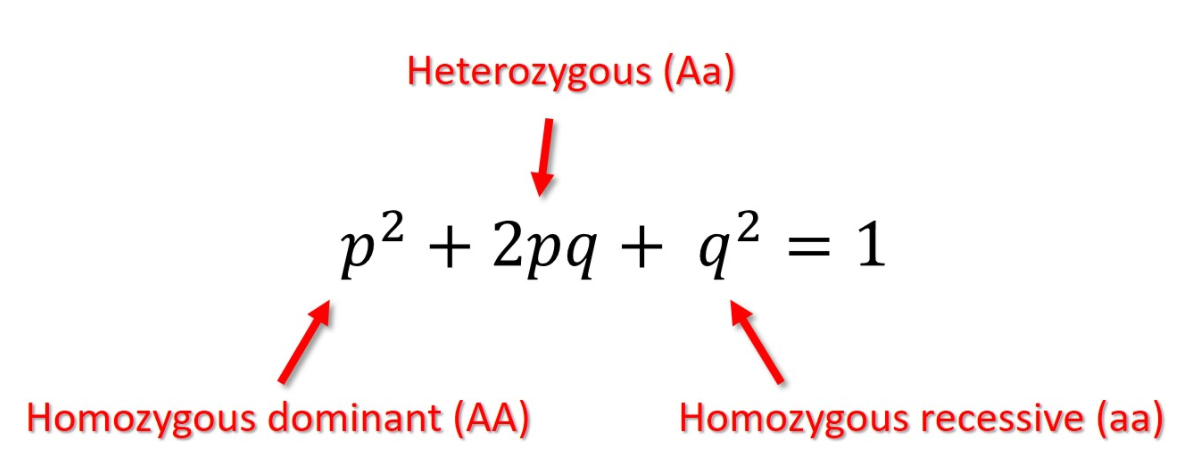
Also, p+q=1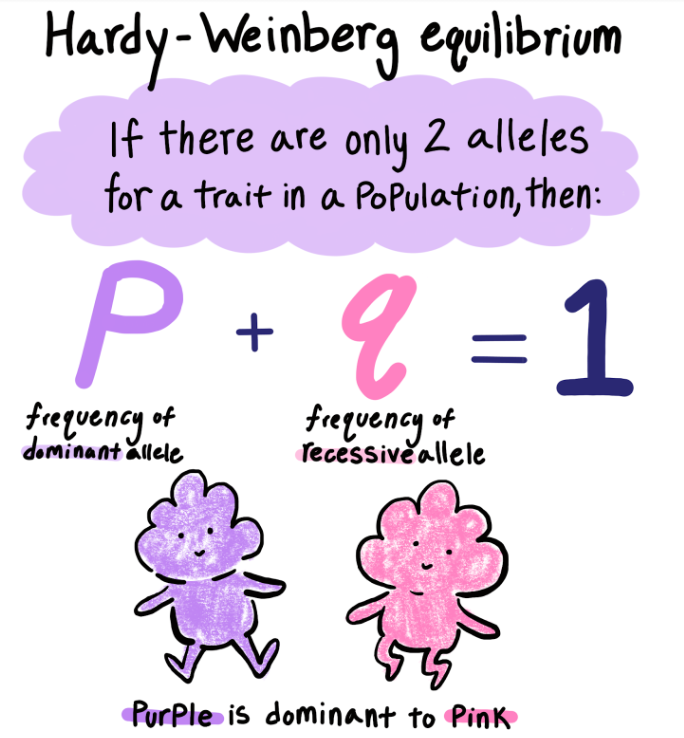
- Disturbance in genetic equilibrium, or Hardy- Weinberg equilibrium, i.e., change of frequency of alleles in a population would then be interpreted as resulting in evolution. Assumptions of Hardy Weinberg equilibrium are :
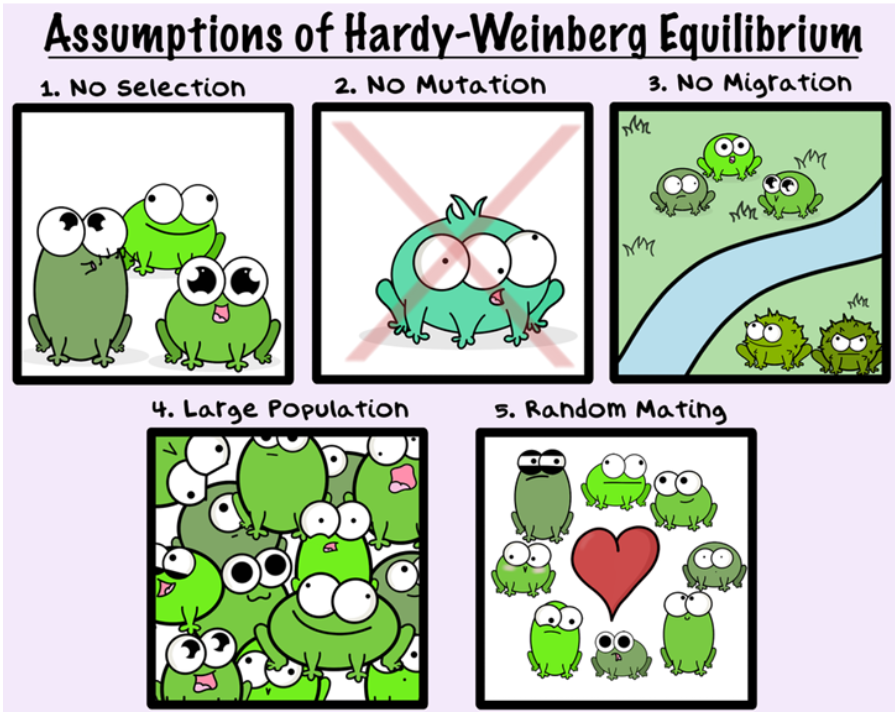
- Five factors are known to affect Hardy-Weinberg equilibrium. These are gene migration or gene flow, genetic drift, mutation, genetic recombination and natural selection.
- When migration of a section of population to another place and population occurs, gene frequencies change in the original as well as in the new population.
- New genes/alleles are added to the new population and these are lost from the old population. There would be a gene flow if this gene migration, happens multiple times.
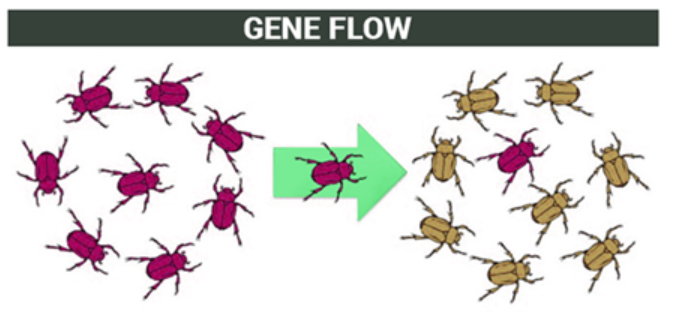
- If the same change occurs by chance, it is called genetic drift.
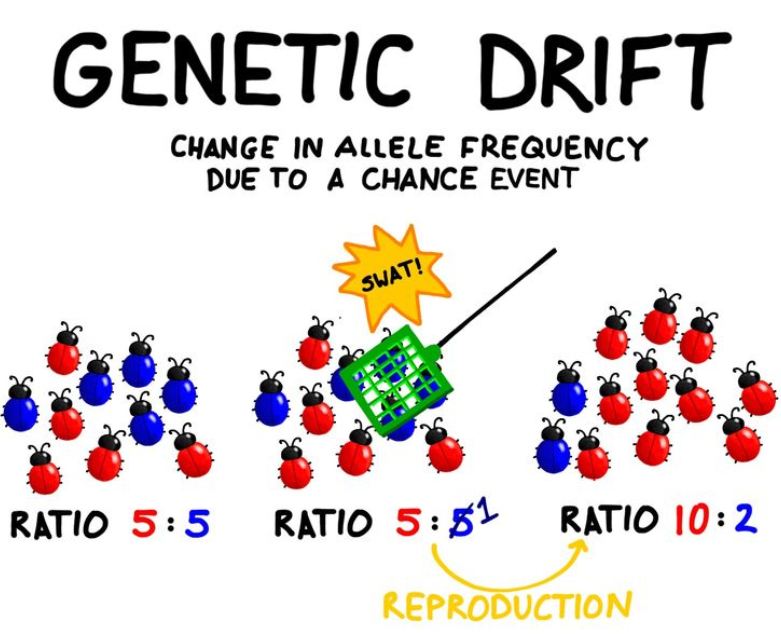
- Sometimes the change in allele frequency is so different in the new sample of population that they become a different species. The original drifted population becomes founders and the effect is called founder effect (a special case of genetic drift).

- Microbial experiments show that pre-existing advantageous mutations when selected will result in observation of new phenotypes. Over a few generations, this would result in Speciation.
- Natural selection is a process in which heritable variations enabling better survival are enabled to reproduce and leave a greater number of progeny.
- A critical analysis makes us believe that variation due to mutation or variation due to recombination during gametogenesis, or due to gene flow or genetic drift results in changed frequency of genes and alleles in future generation.
- Coupled to enhance reproductive success, natural selection makes it look like a different population.
- Natural selection can lead to stabilisation (in which more individuals acquire mean character value), directional change (more individuals acquire value other than the mean character value) or disruption (more individuals acquire peripheral character value at both ends of the distribution curve). Diagrammatic representation :
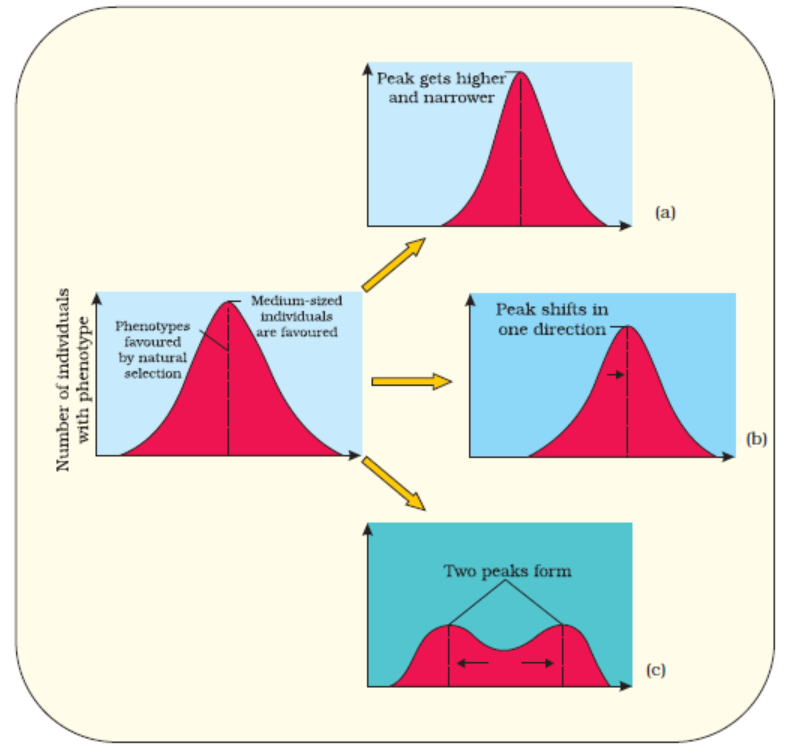
Adaptive Radiation
- Acha apun ne natural selection dekha tha previous sections me jahan humne baat kari thi Darwin ke finches ke bare me ki kaise ek hi island ki population different Galapagos island pe different food source ki availability ke karan unki beak ki shape and relatively body ka size bhi change ho gya tha. Toh ek hi main population different islands par gyi that is radiation and vahan ki food habit ke chalte khud ko uss environment mei dhal lena is adapt karna and collectively hum isko adaptive radiation kehte hain. Toh adaptive radiation ke kafi sare examples hai jinme me humari NCERT 3 examples ko discuss karti hai : Darwin’s finches, Australian marsupials and placental mammals. Finches we have already covered twice so now we will discuss marsupials in brief.
Marsupial wo mammals jo incompletely developed bache ko janam dete hain lekin bacha mom ke pouch me rehta hai jahan wo mature hoga kuch time tak and then bahar nikalta hai. Bahut variety hai aaj ke time pe Autralia me marsupials ki lekin wo sabhi ek hi ancestral stock ke Australia ke ander hi baar baar adaptive radiation se itni diversity generate hui toh jab ek hi jagah par baar baar adaptive radiation ho raha hai toh it leads to convergent evolution or loosely yeah yaad rakhna ki adaptive radiation is linked with convergent evolution. Jab Australia me marsupials evolve kar rhe thy or baki continents par unke parallel me baki mammals bhi evolve kar rhe thy so as to occupy or fill similar ecological niches in other continents too jaise ki Australia and parallely placental mammal me anteater hai hai but dono bahar se dekhne me thode alag dikhte hain, similarly marsupial mouse is named Dasycerus while placental mouse is named Mus. marsupial me flying phalanger evolve hau toh placental me flying squirrel evolve hui in the same ecological niche. Similarly marsupials have Tasmanian in an ecological niche and to occupy the similar range of ecological niche on other continents, placental mammals me Wolf evolve hua. So the baseline is marsupials and placental mammals on other continents have converged to fill a similar range of ecological niches.
A Brief Account Of Evolution
- About 2000 million years ago (mya) the first cellular forms of life appeared on earth.
- Some of these cells had the ability to release O2. The reaction could have been similar to the light reaction in photosynthesis where water is split with the help of solar energy captured and channelised by appropriate light harvesting pigments (like chlorophylls in case of plants).
- Slowly single-celled organisms became multicellular life forms.
- By the time of 500 mya, invertebrates were formed and active.
- Jawless fish probably evolved around 350 mya.
- Sea weeds and few plants existed probably around 320 mya. The first organisms that invaded land were plants. They were widespread on land when animals invaded land.
- Fish with stout and strong fins could move on land and go back to water. This was about 350 mya.
- In 1938, a fish caught in South Africa happened to be a Coelacanth which was thought to be extinct. These animals called lobefins evolved into the first amphibians that lived on both land and water. There are no specimens of these left with us. However, these were ancestors of modern day frogs and salamanders.
- The amphibians evolved into reptiles. They lay thick shelled eggs which do not dry up in sun unlike those of amphibians. Again we only see their modern day descendents, the turtles, tortoises and crocodiles. In the next 200 millions years or so, reptiles of different shapes and sizes dominated on earth.
- Giant ferns (pteridophytes) were present but they all fell to form coal deposits slowly. Some of these land reptiles went back into water to evolve into fish like reptiles probably 200 mya (e.g. Ichthyosaurs). The land reptiles were, of course, the dinosaurs. The biggest of them, i.e., Tyrannosaurus rex was about 20 feet in height and had huge fearsome dagger like teeth.
- About 65 mya, the dinosaurs suddenly disappeared from the earth. We do not know the true reason. Some say climatic changes killed them. Some say most of them evolved into birds. The truth may live in between. Small sized reptiles of that era still exist today.
- The first mammals were like shrews. Their fossils are small sized. Mammals were viviparous and protected their unborn young inside the mother’s body. Mammals were more intelligent in sensing and avoiding danger at least. When reptiles came down mammals took over this earth.
- Due to continental drift, when South America joined North America, these animals were overridden by North American fauna. Due to the same continental drift pouched mammals of Australia survived because of lack of competition from any other mammal.
- Some mammals live wholly in water. Whales, dolphins, seals and sea cows are some examples.
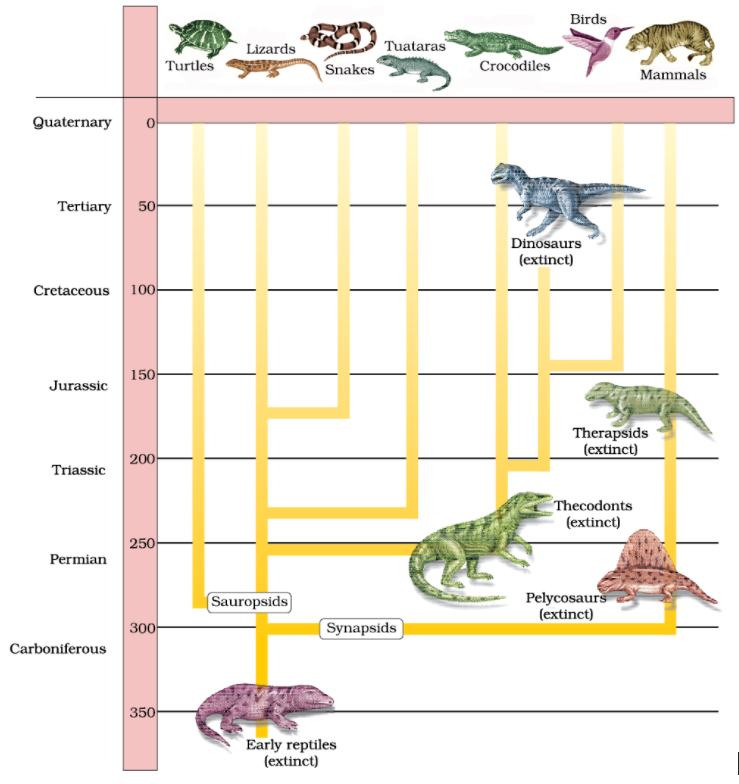
Fig : Representative evolutionary history of vertebrates through geological periods.
Adaptive Radiation
- Adaptive simply refers to the term - adaptation. The changes that occur in organisms with regards to the changing habitat or changing environment in other senses or changes in food habits- all such changes lead to evolution. When different organisms come to live in the same habitat then they will have the same features in common which are better suited to adapt to that environment. The evolution led by these changes is known as convergent evolution which again refers to the fact that different organisms converged to a single habitat and then evolved from there. Adaptive radiation refers to the diversification of a group of organisms into forms filling different ecological roles and it leads to convergent evolution generally seen by presence of analogous organs.
- During his journey Darwin went to the Galapagos Islands. There he observed an amazing diversity of creatures. Of particular interest, small black birds later called Darwin’s Finches amazed him. He realised that there were many varieties of finches on the same island. All the varieties, he conjectured, evolved on the island itself. From the original seed-eating features, many other forms with altered beaks arose, enabling them to become insectivorous and vegetarian finches. This process of evolution of different species in a given geographical area starting from a point and literally radiating to other areas of geography (habitats) is called adaptive radiation. Darwin’s finches represent one of the best examples of this phenomenon.

- number of marsupials, each different from the other evolved from an ancestral stock, but all within the Australian island continent. When more than one adaptive radiation appears to have occurred in an isolated geographical area (representing different habitats), one can call this convergent evolution.

- Placental mammals in Australia also exhibit adaptive radiation in evolving into varieties of such placental mammals each of which appears to be ‘similar’ to a corresponding marsupial (e.g., Placental wolf and Tasmanian wolf-marsupial).

Darwin and Darwin’s Finches :
Australian Marsupial is another example for adaptive evolution :
Origin And Evolution Of Man
- About 15 mya, primates called Dryopithecus and Ramapithecus were existing. They were hairy and walked like gorillas and chimpanzees. Ramapithecus was more man-like while Dryopithecus was more ape-like.

Fig : Dryopithecus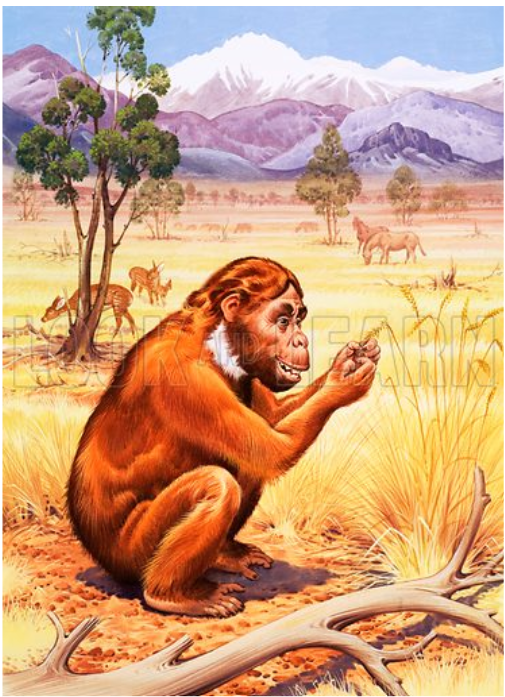
Fig : Ramapithecus - Few fossils of man-like bones have been discovered in Ethiopia and Tanzania. These revealed hominid features leading to the belief that about 3-4 mya, man-like primates walked in eastern Africa. They were probably not taller than 4 feet but walked up right.
- Two mya, Australopithecus probably lived in East African grasslands. Evidence shows they hunted with stone weapons but essentially ate fruit.

- The first human-like being - the hominid and was called Homo habilis. The brain capacities were between 650-800cc. They probably did not eat meat.

- Fossils discovered in Java in 1891 revealed the next stage, i.e., Homo erectus about 1.5 mya. Homo erectus had a large brain around 900cc. Homo erectus probably ate meat. The Neanderthal man with a brain size of 1400cc lived in near east and central Asia between 1,00,000- 40,000 years back. They used hides to protect their body and buried their dead.

- Homo sapiens arose in Africa and moved across continents and developed into distinct races. During ice age between 75,000-10,000 years ago modern Homo sapiens arose. Pre-historic cave art developed about 18,000 years ago. Agriculture came around 10,000 years back and human settlements started. The rest of what happened is part of human history of growth and decline of civilisations.
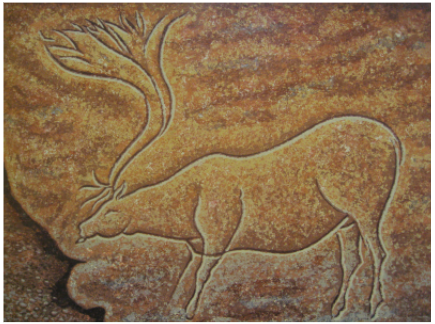
Fig : Prehistoric Cave Art
Biological Evolution
- Jab biologists and science community me evolution ki jikr or ispe study shuru hui thi toh aaj tak prominent names me Darwin ka naam aata hai but he was not the only one. Isse pehle Lamarck ne ek theory di thi on how evolution occurs although the theory was wrong without any proof and was later discarded but still he gave a nudge towards the mechanism of evolution when no one else had a clue ki ho kaise rha hai.
Inki theory thi : “Theory of use and disuse of organs” jiske anusaar organism jis organ ka jyada use karta jata hai wo organ evolve karta rehta hai and jo hissa wo use karna chor deta hai wo regress kar jata hai. Example dia Giraffe ka tree ke upar ki leaves kahne ke liye Giraffe apni garden badhata gya but yeah scientifically true nhi hai and no one uses this theory of use and disuse of organs anymore.
SUMMARY
- The origin of life on earth can be understood only against the background of origin of universe especially earth. Most scientists believe chemical evolution, i.e., formation of biomolecules preceded the appearance of the first cellular forms of life. The subsequent events as to what happened to the first form of life is a conjectured story based on Darwinian ideas of organic evolution by natural selection. Diversity of life forms on earth has been changing over millions of years. It is generally believed that variations in a population result in variable fitness. Other phenomena like habitat fragmentation and genetic drift may accentuate these variations leading to appearance of new species and hence evolution. Homology is accounted for by the idea of branching descent. Study of comparative anatomy, fossils and comparative biochemistry provides evidence for evolution. Among the stories of evolution of individual species, the story of evolution of modern man is most interesting and appears to parallel evolution of human brain and language.
Biological Evolution
- The term biological evolution basically means evolution of life forms. Ab chahe koi bhi life form ho bacteria ho koi animal ho ya koi or life form ho. Biological evolution is basically driven by natural selection - a concept given by Darwin.
- The rate of appearance of new forms is linked to the life cycle or the life span. Microbes that divide fast have the ability to multiply and become millions of individuals within hours.
- Nature selects for fitness and this fitness is based on characteristics which are inherited.
- Adaptive ability is inherited. It has a genetic basis. Fitness is the end result of the ability to adapt and get selected by nature.
- Branching descent and natural selection are the two key concepts of Darwinian Theory of Evolution.
- Branching Descent : the process of development of a new species from a single common descendant. This happens when more and more favourable variations keep accumulating in one descent who eventually evolves into a new species and thus gets separated from its parent species.

- Lamarckism : Before Darwin, another naturalist names Lamarck had said that evolution of life forms had occurred but driven by use and disuse of organs. He gave the examples of Giraffes who in an attempt to forage leaves on tall trees had to adapt by elongation of their necks. As they passed on this acquired character of elongated neck to succeeding generations, Giraffes, slowly, over the years, came to acquire long necks. Nobody believes this conjecture any more.

- Darwinism : Darwin’s concept of evolution by natural selection is known as Darwinism and is an accepted mechanism of evolution although it's an old concept and nowadays new concept known as Neodarwinisn is in play.
- It is possible that the work of Thomas Malthus on populations influenced Darwin.
- Natural selection is based on certain observations which are factual. For example, natural resources are limited, populations are stable in size except for seasonal fluctuation, members of a population vary in characteristics (in fact no two individuals are alike) even though they look superficially similar, most variations are inherited etc.
- The fact that theoretically population size will grow exponentially if everybody reproduced maximally (this fact can be seen in a growing bacterial population) and the fact that population sizes in reality are limited, means that there has been competition for resources.
- Only some survived and grew at the cost of others that could not flourish.
- The novelty and brilliant insight of Darwin was this: he asserted that variations, which are heritable and which make resource utilisation better for few (adapted to habitat better) will enable only those to reproduce and leave more progeny. Hence for a period of time, over many generations, survivors will leave more progeny and there would be a change in population characteristic and hence new forms appear to arise.

Mechanism Of Evolution
- Till now we studied that evolution occurs by natural selection and variations, specifically the favourable variations in an individual are responsible for its fitness and natural selection but What is the origin of this variation and how does speciation occur?
- Even though Mendel had talked of inheritable 'factors' influencing phenotype,Darwin either ignored these observations or kept silence. Had Darwin paid attention to Mendel’s work he would have been able to explain what variations are and how they work and he’d probably have provided physical evidence or not.
- In the first decade of twentieth century, Hugo de Vries based on his work on evening primrose brought forth the idea of mutations – large differences arising suddenly in a population. He believed that it is mutation which causes evolution and not the minor variations (heritable) that Darwin talked about.
- Mutations are random and directionless while Darwinian variations are small and directional.
- Evolution for Darwin was gradual while deVries believed mutation caused speciation and hence called it saltation (single step large mutation).

Hardy-weinberg Principle
- Kisi bhi population me alleles ki frequency constant and stable hoti hai. Ek population me total jitne genes or unke alleles hai wo gene pool kehlata hai. Issi cheez ko hum genetic equilibrium kehte hain and yeah principle bhi yhi kehta hai.
- Sum total of all the allelic frequencies is 1.
- let’s say ki dominant allele ko hum p se represent kare and recessive ko q se represent kre toh p2 (frequency of homozygous dominant allele) + q2 (frequency of homozygous recessive allele) + 2pq (frequency of heterozygous allele) = 1 or we can also say ki pp + qq + 2pq = 1.
- Iss principle ki main assumptions hai ki uss population me koi mutation na ho, selective breeding na ho, natural selection na ho, migration na ho, large population honi chahiyeah and random mating honi chaiyeah. Yeah main assumptions hai iss principle ke.
- Kuch factors aise hai jo iss genetic equilibrium ko disturb kar dete hai. Wo factors hai : Mutation, gene flow/gene migration (ek population se logon ke jana ya new individuals ka aana. Bolo toh emigration and immigration), genetic drift (any sudden chance event jo gene frequency ko badal de), natural selection and genetic recombination (happens during sexual reproduction).
- Jab kisi population me natural evolution operate karta hai toh it can leads to any one of the following three outcomes :
- Stablising : yani ki jis bhi character ke 2 allele thy homozygous dominant and recessive ko hum yahan graphs me 2 extremes lenge and heterozygous character shows the mean. Toh stabilizing population me jyada individuals me mean character hota hai as compared to either of the extremes.
- Directional change : natural selection ek extreme ko favour karega over the other one. Yani ki population me ya homozygous recessive ki frequency jyada hogi ya fir homozygous dominant ki
- Disruption : isme extreme characters wale individuals jyada hote hain or we can say ki aisi population of AA and aa wale individuals jyada hai as compared to the number of individuals with Aa character toh aise graph me aapko 2 peaks dikhengi.
Hardy-weinberg Principle
- This principle says that allele frequencies in a population are stable and is constant from generation to generation. The gene pool (total genes and their alleles in a population) remains constant. This is called genetic equilibrium. Sum total of all the allelic frequencies is 1.
- In a given population one can find out the frequency of occurrence of alleles of a gene or a locus. This frequency is supposed to remain fixed and even remain the same through generations. Hardy-Weinberg principle stated it using algebraic equations :

Also, p+q=1
- Disturbance in genetic equilibrium, or Hardy- Weinberg equilibrium, i.e., change of frequency of alleles in a population would then be interpreted as resulting in evolution. Assumptions of Hardy Weinberg equilibrium are :

- Five factors are known to affect Hardy-Weinberg equilibrium. These are gene migration or gene flow, genetic drift, mutation, genetic recombination and natural selection.
- When migration of a section of population to another place and population occurs, gene frequencies change in the original as well as in the new population.
- New genes/alleles are added to the new population and these are lost from the old population. There would be a gene flow if this gene migration, happens multiple times.

- If the same change occurs by chance, it is called genetic drift.

- Sometimes the change in allele frequency is so different in the new sample of population that they become a different species. The original drifted population becomes founders and the effect is called founder effect (a special case of genetic drift).

- Microbial experiments show that pre-existing advantageous mutations when selected will result in observation of new phenotypes. Over a few generations, this would result in Speciation.
- Natural selection is a process in which heritable variations enabling better survival are enabled to reproduce and leave a greater number of progeny.
- A critical analysis makes us believe that variation due to mutation or variation due to recombination during gametogenesis, or due to gene flow or genetic drift results in changed frequency of genes and alleles in future generation.
- Coupled to enhance reproductive success, natural selection makes it look like a different population.
- Natural selection can lead to stabilisation (in which more individuals acquire mean character value), directional change (more individuals acquire value other than the mean character value) or disruption (more individuals acquire peripheral character value at both ends of the distribution curve). Diagrammatic representation :

A Brief Account Of Evolution
- Iss section me hum ek choti si summary dekhenge ki over the millions of years which species evolved and flourished when. Halanki iss section me generally higher level par hum earth ke geological time scale ki terms me baat karte hain but NCERT doesn’t mention them so we will also not give importance to them…
- Lagbhag 2000 million years ago (mya) pehli cellular forms appear hui thi jinme me se kuch photosynthetic species oxygen release karne ki ability rakhti thi jinke karan primitive earth ka anoxygenic, reducing environment, oxygenic environment me badalne laga.
- Fir single cell se multicellular forms evolve hui.
- Yeah sab hote hote, aaj se lagbhag 500 mya invertebrates bane or wo active animal life forms thi.
- Unke baad or we can say ki aaj se 350 million saal pehle jawless fishes arrive hui.
- Inke baad, lagbag 320 mya plants evolve hue and plants land ko invade karne wale first organisms thy.
- Fishes se amphibians evolve hue, amphibian se reptiles evolve hue and then reptiles se aves evolve hue.
- Lagbhag 200 million saal pehle kuch reptiles wapis pani me chale gye to evolve into fish like reptiles jaise ki Ichthyosaurus.
- Around 65 mya Dinosaurs went extinct.
- First mammals were like shrews. Kuch mammals jaise ki whales, dolphins and seals permanently paani me rehne lag gye to wo dekhne me mammals kam, fish jyada lagte hai.
- Ab chapter ke end ki taraf badhte hue hum next and last section me human ka origin and evolution discuss karenge.
A Brief Account Of Evolution
- About 2000 million years ago (mya) the first cellular forms of life appeared on earth.
- Some of these cells had the ability to release O2. The reaction could have been similar to the light reaction in photosynthesis where water is split with the help of solar energy captured and channelised by appropriate light harvesting pigments (like chlorophylls in case of plants).
- Slowly single-celled organisms became multicellular life forms.
- By the time of 500 mya, invertebrates were formed and active.
- Jawless fish probably evolved around 350 mya.
- Sea weeds and few plants existed probably around 320 mya. The first organisms that invaded land were plants. They were widespread on land when animals invaded land.
- Fish with stout and strong fins could move on land and go back to water. This was about 350 mya.
- In 1938, a fish caught in South Africa happened to be a Coelacanth which was thought to be extinct. These animals called lobefins evolved into the first amphibians that lived on both land and water. There are no specimens of these left with us. However, these were ancestors of modern day frogs and salamanders.
- The amphibians evolved into reptiles. They lay thick shelled eggs which do not dry up in sun unlike those of amphibians. Again we only see their modern day descendents, the turtles, tortoises and crocodiles. In the next 200 millions years or so, reptiles of different shapes and sizes dominated on earth.
- Giant ferns (pteridophytes) were present but they all fell to form coal deposits slowly. Some of these land reptiles went back into water to evolve into fish like reptiles probably 200 mya (e.g. Ichthyosaurs). The land reptiles were, of course, the dinosaurs. The biggest of them, i.e., Tyrannosaurus rex was about 20 feet in height and had huge fearsome dagger like teeth.
- About 65 mya, the dinosaurs suddenly disappeared from the earth. We do not know the true reason. Some say climatic changes killed them. Some say most of them evolved into birds. The truth may live in between. Small sized reptiles of that era still exist today.
- The first mammals were like shrews. Their fossils are small sized. Mammals were viviparous and protected their unborn young inside the mother’s body. Mammals were more intelligent in sensing and avoiding danger at least. When reptiles came down mammals took over this earth.
- Due to continental drift, when South America joined North America, these animals were overridden by North American fauna. Due to the same continental drift pouched mammals of Australia survived because of lack of competition from any other mammal.
- Some mammals live wholly in water. Whales, dolphins, seals and sea cows are some examples.

Fig : Representative evolutionary history of vertebrates through geological periods.
Origin And Evolution Of Man
- Humans and Gorilla, Orangutan me kafi homology hai at the genetic level. Humans me 46 chromosome hai lekin Gorilla and Orangutan me 48. Dono ke DNA me 99% similarities hai. Humans are most closely related to great apes like Gorilla and Chimpanzee.
- 15 million years ago, Dryopithecus and Ramapithecus primates exist karte thy. Jisme se Dryopithecus ape se jyada milta julta hai and Ramapithecus me changes aane shuru hue. Dono hi chimpanzee ki tarah hairy thy and unhi ki tarah chalte thy.
- Fir aaya Australopithecus jiske fossils pliocene rocks me Africa me tuang area ke pass se mile hai toh iss fossil ko hum tuang bhi bol dete hai. Yeah lagbhag 5 million saal pehle appear hue toh lagbhag aaj se 1.5 million saal pehle tak jeevit thy. They gave rise to Homo habilis nearly 2 years ago. Brain capacity inki 500cc ki thi.
- Fir aata hai Homo habilis jisko hum skillful man bhi kehte hain kyunki yeah pehle tool makes thy. Shayad meat ni khate thy yeah and inki brain capacity 600-800cc ke aas pass thi. Yeah 2 million year pehle tak jeevit thy and then inke baad aaya homo erectus.
- Homo erectus around 1.5mya ke aas pass originate hua hai and iske fossils hume java me mile hai. Brain capacity was 900 cc. Yeah shayad meat khate thy and inke fossils btate hai ki homo erectus me male females ke mukable lambe thy. Inki chaal dhaal thodi insano ki tarah thi yani ki upright posture isiliye ‘erectus’ word use kia hai name me. Baki feature me we have : protruding jaws, projecting bow ridges, small canines and molar teeth large thy inke. Shayad inko fire ka use karna aata tha. Iss category me 3 different fossils hai apne pass : java man, peking man and heidelberg man
- Java man or homo erectus erectus me legs long and erect thy but chalte waqt bent hote thy. Choti chin, chaudi naak, low forehead and bow ridges high thy. Yeah inke facial feature hain, lower jaw ki canoe badi thi. Yeah pehla prehistoric man hai jisne hunting, defense and cooking ke liye fire use ki hogi.
- Then came homo erectus peking or peking man. Inhi ka dusra naam Sinanthropus bhi hai. Brain capacity 1100cc thi and inke dwara fire use karne ke clear evidence hai apne pass. Features me java man ke jaisa hi tha but shorter and lighter.
- Fir aata hai homo erectus heidelbergensis jiske fossils hume Germany me mile hain. Brain capacity 1300 cc. Features more or less similar to java man but inka jaw ape jaisa tha lekin usme daant aaj ke present humans jaise thy toh this was one step closer to evolution.
- Neanderthal man : brain capacity 1400cc. Existed nearly 1 lakh to 40,000 years ago. Fossils hume Europe, Asia and Africa ke kuch parts se mile hain. Yeah apni tarah chalte thy. Prognathous mouth. Adapted to cold environment. Yeah mahir shikari thy and cannibals bhi. Yeah shikar karke hue animals ki skin ko use karte thy khud ko cold se protect karne ke liye but yeah mana ja rha hai ki Neanderthal man aage evolve nhi hua.
- Cro-Magnon man/Homo sapiens : yeah apne most recent ancestors hai jo 34,000 saal pehle Holocene epoch me appear hue. Inke cranial capacity 16500cc thi yani ki aaj ke human se bhi jyada. They lived with families. Chalna, firna, daudna aaj ke humans ki tarah hi tha and they used to do Cave paintings. Omnivorous they and inke aaj ke humans ka direct ancestor kaha jata hai.
- Homo sapien sapien is the modern man jo 75000 saal pehle Holocene epoch me appear hua. Prehistoric art caves me 18,000 saal pehle hua. Inhone ne hi agriculture shuru kia lagbhag aaj se 10,000 saal pehle.
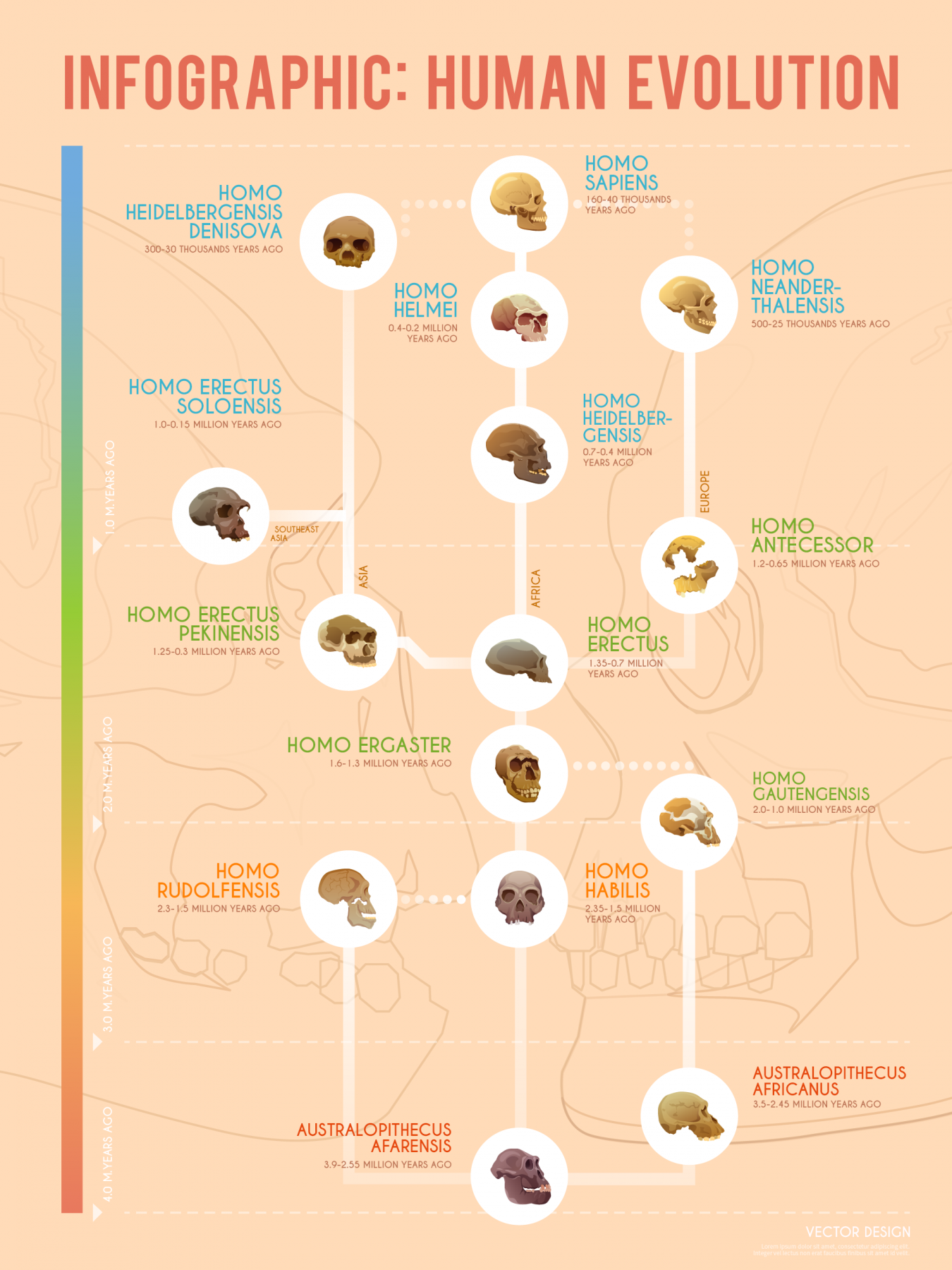
Origin And Evolution Of Man
- About 15 mya, primates called Dryopithecus and Ramapithecus were existing. They were hairy and walked like gorillas and chimpanzees. Ramapithecus was more man-like while Dryopithecus was more ape-like.

Fig : Dryopithecus
Fig : Ramapithecus - Few fossils of man-like bones have been discovered in Ethiopia and Tanzania. These revealed hominid features leading to the belief that about 3-4 mya, man-like primates walked in eastern Africa. They were probably not taller than 4 feet but walked up right.
- Two mya, Australopithecus probably lived in East African grasslands. Evidence shows they hunted with stone weapons but essentially ate fruit.

- The first human-like being - the hominid and was called Homo habilis. The brain capacities were between 650-800cc. They probably did not eat meat.

- Fossils discovered in Java in 1891 revealed the next stage, i.e., Homo erectus about 1.5 mya. Homo erectus had a large brain around 900cc. Homo erectus probably ate meat. The Neanderthal man with a brain size of 1400cc lived in near east and central Asia between 1,00,000- 40,000 years back. They used hides to protect their body and buried their dead.

- Homo sapiens arose in Africa and moved across continents and developed into distinct races. During ice age between 75,000-10,000 years ago modern Homo sapiens arose. Pre-historic cave art developed about 18,000 years ago. Agriculture came around 10,000 years back and human settlements started. The rest of what happened is part of human history of growth and decline of civilisations.

Fig : Prehistoric Cave Art
SUMMARY
- The origin of life on earth can be understood only against the background of origin of universe especially earth. Most scientists believe chemical evolution, i.e., formation of biomolecules preceded the appearance of the first cellular forms of life. The subsequent events as to what happened to the first form of life is a conjectured story based on Darwinian ideas of organic evolution by natural selection. Diversity of life forms on earth has been changing over millions of years. It is generally believed that variations in a population result in variable fitness. Other phenomena like habitat fragmentation and genetic drift may accentuate these variations leading to appearance of new species and hence evolution. Homology is accounted for by the idea of branching descent. Study of comparative anatomy, fossils and comparative biochemistry provides evidence for evolution. Among the stories of evolution of individual species, the story of evolution of modern man is most interesting and appears to parallel evolution of human brain and language.
